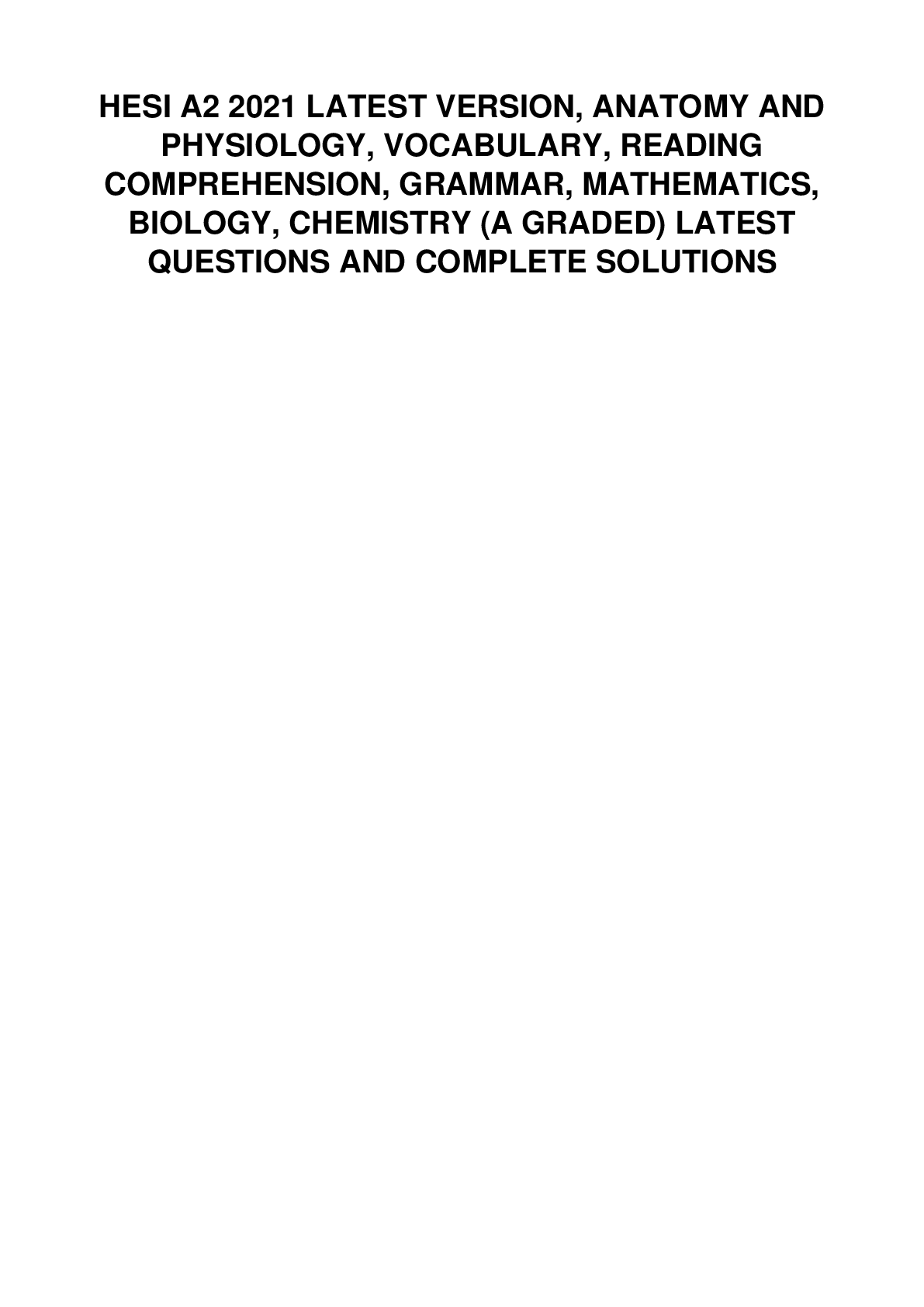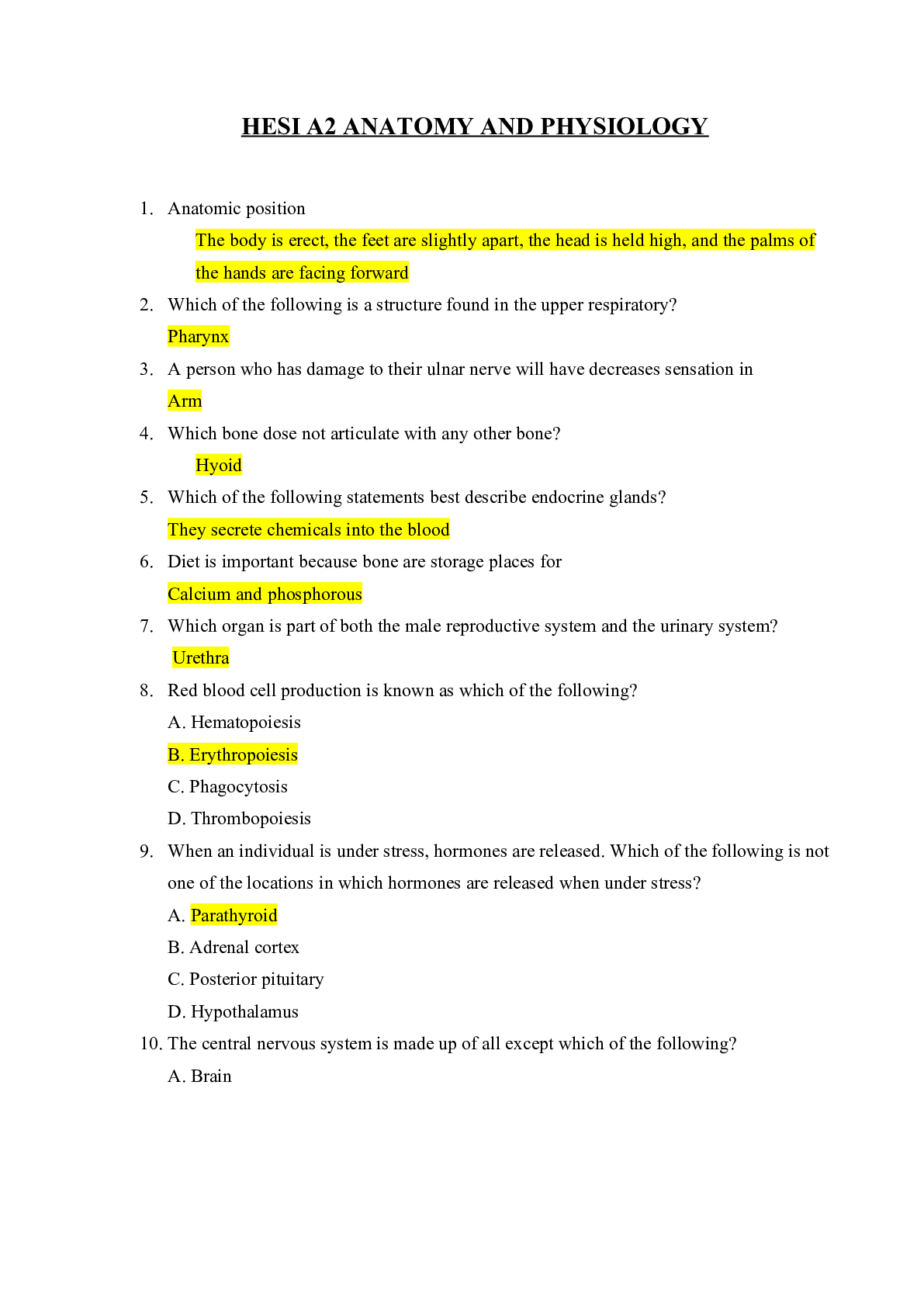*NURSING > HESI > HESI A2 Anatomy and Physiology Study Guide All versions for Completed for 2022/2023 (All)
HESI A2 Anatomy and Physiology Study Guide All versions for Completed for 2022/2023
Document Content and Description Below
HESI A2 Anatomy and Physiology Study GuideTable of Contents: Lesson 1 Skeletal System.......................................................................1 Lesson 2 Body Directions/Plans.......... .....................................................10 Lesson 3 Muscular System....................................................................22 *Lesson 4 Circulatory System................................................................27 *Lesson 5 Endocrine/Hormone System.................................................34 Lesson 6 Urinary System.......................................................................38 Lesson 7 Integumentary System............................................................43 Lesson 8 Digestive System....................................................................48 *Lesson 9 Nervous System....................................................................51 *Lesson 10 Senses System...................................................................55 *Lesson 11 Immune System..................................................................58Lesson 12 Reproductive System...........................................................61 Comprehensive Practice Test................................................................61 Answer Key For All Lessons & Practice Test.........................................681 Xiphoid Process (pointy end of sternum) Did you know? Ligaments are made from connective tissues. Ligaments connect bones to other bones to form joints like the ball and socket joint. Tendons, on the other hand, connect bones to muscles.2 © 2017 All Rights Reserved. www.ReadyForTheHESI.org3 © 2017 All Rights Reserved. www.ReadyForTheHESI.org4 © 2017 All Rights Reserved. www.ReadyForTheHESI.org11 Practice Worksheet Name any bone associated with the body part. Upper Arm: Ex: Humerus Hand: _______________________ Foot: _______________________ Head: ________________________ Hip: ________________________ Upper Leg: ________________________ Lower Arm: ________________________ Lower leg: ________________________ Name the body part associated with the bone. Ulna: Ex: Lower arm Clavicle: ________________________ Metatarsal: ________________________ Maxilla: ________________________ Sternum: ________________________ Pelvic: ________________________ Femur: ________________________ Mandible: ______________________ Talus: ______________________ Fibula: ______________________ Ribs: ______________________ Tibia: ______________________ Metacarpals: ______________________ Name bones found in the following regions: Head: 1. Z 2. M 3. M Chest, Shoulder, Collar Bone, and Spine: 1. C 2. S 3. R 4. V 5. S Arm: 1. H 2. U 3. R 4. C 5. M 6. P Hips: 1. P 2. S Upper Leg: 1. F Kneebone: 1. P Lower leg: 1. T 2. F Foot: 1. T 2. C 3. T 4. M 5. P2 © 2017 All Rights Reserved. www.ReadyForTheHESI.org Lesson 1, Practice 1: Skeletal System 1. Where is the ulna located? A. leg B. head C. arm D. hip 2. How many thoracic vertebrae are there? A. 12 B. 13 C. 14 D. 15 3. Which of these is NOT part of a leg bone? A. tibia B. fibula C. tarsals D. femur 4. Which of these is NOT part of arm and hand bones? A. humerus B. ulna C. metatarsals D. carpals 5. Where is the cranium located? A. arm B. head C. leg D. hip 6. Which bone is the pelvic girdle associated with? A. sacrum B. femur C. sternum D. clavicle 7. Which bone can be found in the foot? A. radius B. clavicle C. scapula D. calcaneus 8. Which of the below is also called a breastbone? A. sternum B. clavicle C. scapula D. fibula 9. The _______ is the bone structure of a person’s jaw. A. zygomatic B. maxilla C. mandible D. cranium 10. Which of the following is part of the lower leg? A. femur B. tibia C. ulna D. sacrum 11. How many lumbar vertebrae are there? A. 4 B. 5 C. 6 D. 7 12. Which of the below is NOT associated with the patella? A. scapula B. tibia C. femur D. fibula 13. Which bone is part of the thigh? A. tibia B. femur C. fibula D. talus 14. ______ is also called your cheekbone. A. zygomatic B. maxilla C. mandible D. cranium 15. Which of these is NOT part of the hand bones? A. metacarpals B. metatarsals C. phalanges D. carpals 16. _____ is a bone that makes up the foot. A. coccyx B. talus C. radius D. femur 17. ___ makes up part of the shoulder. A. scapula B. tibia C. fibula D. patella 18. ____ are also called digits. A. clavicle3 B. sternum C. phalanges D. talus4 © 2017 All Rights Reserved. www.ReadyForTheHESI.org 19. Cervicle, Thoracic, Lumbar are types of ___ bones. A. hip B. vertebrae C. pelvic D. mandible 20. ____ is also called the tailbone. A. sacrum B. coccyx C. femur D. scapula 21. The ___ is also called the hip bone. A. pelvis B. sternum C. patella D. calcaneus 22. These bones cage your lungs: A. phalanges B. vertebrae C. ribs D. talus 23. Metatarsals are part of the ___. A. foot B. hand C. upper leg D. upper arm 24. How many cervical vertebrae are there? A. 5 B. 6 C. 7 D. 8 25. How many total bones in the body? A. 1120 B. 605 C. 206 D. 82 26. What is the name of the fluid found around the cavities of the patella to facilitate movement and shock absorption? A. interstitial fluid B. fluid C. synovial fluid D. plasma 27. Which three bones articulate in the elbow joint? A. sacrum, coccyx, and femur B. phalanges, ribs, and talus C. humerus, radius, and ulna D. humerus, femur, and radius 28. The hyoid is superior to the A. larynx B. mandible C. cerebellum D. cranium 29. The xiphoid process is superior to the A. larynx B. mandible C. ribs D. humerus Lesson 1, Practice 2: Skeletal System 1. Which of the following is found in the chest? A. metacarpals B. metatarsals C. sacrum D. sternum5 © 2017 All Rights Reserved. www.ReadyForTheHESI.org 2. Which of the following attaches the upper teeth of a person’s mouth? A. mandible B. maxilla C. clavicle D. scapula 3. Which of the following are wrist bones? A. tarsals B. carpals C. phalanges D. calcaneus 4. Which one is NOT part of the vertebral spine? A. thoracic B. clavicle C. cervical D. lumbar 5. Which of the following is found in the foot? A. talus B. tibia C. patella D. radius 6. Which of the following is NOT found in the foot? A. metacarpals B. metatarsals C. phalanges D. calcaneus 7. Which of the following is found in the lower leg? A. femur B. fibula C. humerus D. sternum 8. Which bone is bigger in thickness? A. tibia B. fibula 9. Which bone is on the side of the thumb (lateral)? A. ulna B. radius 10. Which bone does not belong with the others? A. humerus B. fibula C. ulna D. radius 11. Which of the following is in closer range to the scapula? A. clavicle B. tibia C. carpals D. ulna 12. The calcaneus bone is found in the: A. arm B. leg C. head D. foot 13. How many thoracic and where are they found? A. 12 found in the neck area B. 12 found in the chest area C. 13 found in the neck area D. 13 found in the chest area 14. The humerus is found in the: A. arm B. leg C. head D. foot 15. The talus is found in the: A. arm B. leg C. head D. foot 16. The metatarsals are found in the: A. arm B. leg C. head D. foot 17. The metacarpals are found in the: A. arm B. leg C. head D. foot 18. The carpals are found in the: A. arm B. leg C. head D. foot 19. The tarsals are found in the:6 © 2017 All Rights Reserved. www.ReadyForTheHESI.org A. arm B. leg C. head D. foot 20. Which bone joins with the pelvic bone? A. scapula B. sacrum C. sternum D. patella 21. Which bone is part of the jaw? A. mandible B. maxilla C. metacarpals D. clavicle 22. Which is part of the lower leg? A. femur B. scapula C. coccyx D. fibula 23. Talus is a bone found in the: A. arm B. leg C. head D. foot 24. The clavicle is the: A. vertebrae B. breastbone C. collarbone D. rib 25. How many total spinal vertebrae are there? A. 24 B. 25 C. 26 D. 27 26. How many cervical and where are they found? A. 6 found in the chest area B. 6 found in the neck area C. 7 found in the chest area D. 7 found in the neck area 27. How many lumbar vertebrae are there? A. 7 B. 12 C. 5 D. 6 28. When a baseball pitcher winds up his shoulder, he is using which joint? A. hinge joint B. ball and socket joint C. immovable joint D. cartilagenous joint Lesson 1, Practice 3: Skeletal System Use the process of elimination to answer the questions below. 1. Which of these is found in the head? A. tibia B. sphenoid bone C. fibula D. radius 2. Which of these is found in the arm? A. cranium B. femur C. calcaneus D. coronoid process 3. Which of these is found in the pelvic girdle? A. ilium B. phalanges C. talus D. fibula 4. Which of these is found in the hand? A. metatarsals B. pelvic C. scaphoid D. clavicle 5. Which of these is found in the foot? A. sternum B. cuboid C. clavicle D. scapula 6. Which of these is found in the cranium? A. ribs B. patella C. vomer D. carpals 7. Which of these is found in the thoracic area? A. xiphoid process B. zygomatic C. maxilla D. metatarsals 8. Which of these is found in the cranium? A. ulna B. femur C. occipital7 © 2017 All Rights Reserved. www.ReadyForTheHESI.org D. sacrum 9. Which of these is found in the cranium? A. clavicle B. temporal C. fibula D. coccyx 10. Which of these is found in the thigh? A. tibia B. fibula C. trochanter D. humerus 11. Which of these is found in the cranium? A. metacarpals B. coccyx C. talus D. lacrimal 12. Which of these is found in the foot? A. carpals B. femur C. navicular D. sternum 13. Which of these is found in the foot? A. olecranon fossa B. talus C. transverse process D. styloid process 14. Which of these is found in the pelvic girdle? A. styloid process B. lunate C. sacrum D. pisiform 15. Which of these is found in the leg? A. trapezium B. fibula C. triquetrum D. lumbar 16. Which of these is medial? A. tibia B. fibula 17. Which of these is lateral? A. tibia B. fibula 18. Which of these is medial? A. ulna B. radius 19. Which of these is lateral? A. ulna B. radius8 © 2017 All Rights Reserved. www.ReadyForTheHESI.org Lesson 2: Directional Terms, Regions, and Body Planes9 © 2017 All Rights Reserved. www.ReadyForTheHESI.org Practice Worksheet: Fill in the blanks. Body Quadrants and Regions:10 © 2017 All Rights Reserved. www.ReadyForTheHESI.org11 © 2017 All Rights Reserved. www.ReadyForTheHESI.org Body Planes:12 © 2017 All Rights Reserved. www.ReadyForTheHESI.org13 © 2017 All Rights Reserved. www.ReadyForTheHESI.org Body Planes: Label the diagrams.14 © 2017 All Rights Reserved. www.ReadyForTheHESI.org Lesson 2: Directional Terms, Regions, and Body Planes Word Meaning Example Superior Up, or above The cranium is superior to the clavicle. Inferior Below The mouth is inferior to the eyes. Ventral/Anterior Towards the front of the body The sternum is ventral to the spine. Dorsal/Posterior Towards the back of the body; behind The spine is posterior to the heart. Medial Towards the midline of the body The chest is medial to the arms. Lateral Away from the midline of the body; to the side The ears are lateral to the eyes. Proximal Closer to the trunk of the body; closer to the point of attachment The elbow is proximal to the wrist. Distal Away from the trunk of the body; away from the point of attachment The patella is distal to the femur. Superficial Towards the surface of the body The skin is superficial to the bones. Deep Away from the surface of the body; internal The muscles are deep to the skin Frontal Plane Cuts the body from dorsal and ventral parts (back and front) Separating nose from back of head. Median/Midsagittal Plane Cuts the body in left and right parts, right down the midline Separating the right and left arm. Transverse Plane Cuts the body from superior and inferior parts, top and bottom Separating the upper body from the lower body. Right Hypochondriac Right upper section of abdominopelvic region Organ found here: the liver Epigastric Central upper section of abdominopelvic region Organ found here: the stomach Left Hypochondriac Left upper section of abdominopelvic region Organ found here: part of the stomach Right Lumbar Right middle section of abdominopelvic region Organ found here: colon Umbilical Most centered section of abdominopelvic region Organ found here: small intestines Left Lumbar Left middle section of abdominopelvic region Organ found here: colon Right Iliac/Inguinal Right lower section of abdominopelvic region Organ found here: appendix Hypogastric Central lower section of abdominopelvic region Organ found here: bladder Left Iliac/Inguinal Left lower section of abdominopelvic region Organ found here: colon15 © 2017 All Rights Reserved. www.ReadyForTheHESI.org Lesson 2: Fill in the Blank Word Meaning Example Up, or above The feet are inferior to the legs. The ribs are anterior to the heart. Dorsal/Posterior Closer to the center of the body Lateral Proximal The wrist is distal to the elbow. Superficial Deep Cuts the body from dorsal and ventral parts (back and front) --------------- Median/Midsagittal Plane --------------- Transverse Plane --------------- Right upper section of abdominopelvic region Left side of the stomach is found in this region Most of the entire body of the stomach can be found here Right Lumbar region Small intestines can be found in this region Left middle section of abdominopelvic region Right Iliac/Inguinal Left Iliac/Inguinal16 © 2017 All Rights Reserved. www.ReadyForTheHESI.org The urinary bladder can be found here Lesson 2, Practice 1, Directional Terms 1. The cranium is _____ to the mandible. A. Anterior B. Posterior C. Superior D. Inferior 2. The skin is _____ to the bones. A. Lateral B. Medial C. Deep D. Superficial 3. The ulna is ______ to the phalanges. A. Proximal B. Distal C. Ventral D. Anterior 4. The femur is ____ to the tarsals. A. Proximal B. Distal C. Ventral D. Anterior 5. The sternum is ____ to the heart. A. Superior B. Anterior C. Inferior D. Posterior 6. The spine is ____ to the sternum. A. Superior B. Anterior C. Inferior D. Posterior 7. The small intestines are ___ to the stomach. A. Dorsal B. Ventral C. Superior D. Inferior 8. The muscles are ___ to the skin. A. Dorsal B. Deep C. Distal D. Proximal 9. The ulna is ____ to the radius. A. Medial B. Lateral C. Superior D. Inferior 10. The patella is ____ to the femur. A. Superficial B. Dorsal C. Proximal D. Distal 11. The spine is ____ to the heart. A. Inferior B. Ventral C. Dorsal D. Anterior 12. The coccyx is ____ to the sacrum. A. Inferior B. Posterior C. Dorsal D. Superficial 13. What is the meaning of dorsal? A. In front of B. Closest to the trunk C. Behind D. Farthest from the trunk 14. What is the meaning of ventral? A. In front of B. Closest to the trunk C. Behind D. Farthest from the trunk17 © 2017 All Rights Reserved. www.ReadyForTheHESI.org Lesson 2 Practice 2, Directional Terms 1. The clavicle is _____ to the ribs. A. Anterior B. Posterior C. Superior D. Inferior 2. What kind of cut is the frontal plane? A. Top to bottom B. Left side and right side C. Ventral and dorsal side D. Oblique and diagonal sides 3. The bones are ______ to the skin. A. Lateral B. Medial C. Deep D. Superficial 4. The calcaneus is ____ to the tibia. A. Proximal B. Distal C. Ventral D. Anterior 5. What kind of cut is the transverse plane? A. Top to bottom B. Left side and right side C. Ventral and dorsal side D. Oblique and diagonal 6. The fibula is ____ to the pelvic girdle. A. Proximal B. Distal C. Ventral D. Anterior 7. The heart is ___ to the ribs. A. Superior B. Anterior C. Inferior D. Posterior 8. The sternum is ____ to the vertebrae. A. Superior B. Anterior C. Inferior D. Posterior 9. What kind of cut is the median plane? A. Top and bottom B. Left side and right side C. Ventral and dorsal side D. Oblique and diagonal 10. The esophagus is ___ to the colon. A. Dor sal B. Ven tral C. Sup erior D. Inferior 11. The tibia is ____ to the metatarsals. A. Dor sal B. Dee p C. Dist al D. Proximal 12. The radius is ____ to the ulna. A. Medial B. Lateral C. Superior D. Inferior 13. The femur is ___ to the fibula. A. Superficial B. Dorsal C. Proximal D. Distal 14. The spine is ____ to the heart. A. Inferior B. Ventral C. Dorsal D. Anterior 15. The sacrum is ____ to the coccyx. A. Superior B. Posterior C. Dorsal D. Superficial 16. What is the meaning of posterior? A. In front of18 © 2017 All Rights Reserved. www.ReadyForTheHESI.org B. Closest to the trunk C. Behind D. Farthest from the trunk 17. What is the meaning of anterior? A. In front of B. Closest to the trunk C. Behind D. Farthest from the trunk Lesson 2 Practice 3, Directional Terms 1. Which organ is found in the right hypochondriac region? A. Stomach B. Bladder C. Liver D. Appendix 2. The head is ____ to the chest. A. Anterior B. Posterior C. Superior D. Inferior 3. The elbow is ____ to the hand. A. Inferior B. Superior C. Distal D. Proximal 4. The spine is ____ to the chest. A. Ventral B. Dorsal C. Proximal D. Distal 5. The tibia is ___ to the fibula. A. Deep B. Lateral C. Medial D. Superficial 6. The fibula is ____ to the tibia. A. Deep B. Lateral C. Medial D. Superficial 7. Which organ is found in the hypogastric region? A. Stomach B. Bladder C. Liver D. Appendix 8. Which organ is found in the epigastric region? A. Stomach B. Bladder C. Liver D. Appendix 9. Which organ is found in the right iliac region? A. Bladder B. Appendix C. Stomach D. Gall bladder 10. The scapula is ____ to the ribs. A. Ventral B. Dorsal C. Medial D. Lateral 11. Which organ is found in the left lumbar region? A. Colon B. Stomach C. Liver D. Bladder 12. Which organ is found in the umbilical region? A. Small intestines B. Stomach C. Colon D. Appendix 13. Which organ is found in the right lumbar region? A. Stomach B. Colon C. Bladder D. Appendix19 © 2017 All Rights Reserved. www.ReadyForTheHESI.org Lesson 3: Muscular System:20 © 2017 All Rights Reserved. www.ReadyForTheHESI.org ** The quadriceps group includes: vastus lateralis, vastus medius, vastus intermedius, and the rectus femoris. Vastus Intermedius cannot be seen on this diagram because it is deep.21 © 2017 All Rights Reserved. www.ReadyForTheHESI.org Muscles are one of 4 main body tissue types.22 © 2017 All Rights Reserved. www.ReadyForTheHESI.org Lesson 3: Label the diagram. Lesson 3 Practice 1, Muscular23 © 2017 All Rights Reserved. www.ReadyForTheHESI.org System 1. Where is the latissimus dorsi found? A. Head B. Arm C. Leg D. Back 2. Where is the garcilis found? A. Head B. Arm C. Leg D. Back 3. Where is the serratus anterior found? A. Head B. Chest C. Arm D. Leg 4. Which of these is part of the quadriceps group? A. Teres Major B. Vastus Lateralis C. Biceps Femoris D. Tibialis Anterior 5. Which if these is found in the back of upper body? A. Gastrocnemius B. Achilles Tendon C. Orbicularis Oculi D. Trapezius 6. Which if these is found around the eye? A. Orbicularis Oculi B. Orbicularis Oris C. Brachialis D. Teres Major 7. Which if these is found around the mouth? A. Orbicularis Oculi B. Orbicularis Oris C. Brachialis D. Teres Major 8. Which of these is found in the shoulder? A. Deltoid B. Trapezius C. Latissimus Dorsi D. Pectoralis Major 9. Which of these is found in the neck? A. Deltoid B. Trapezius C. Sternocleidomastoid D. Serratus Anterior 10. Which of these is found in the arm? A. Biceps brachii B. Biceps femoris C. Obliques D. Gracilis 11. Which of these is found in the lower leg? A. Trapezius B. Tibialis Anterior C. Serratus Anterior D. Biceps Brachii 12. Which of these is found in the front chest? A. Sternocleidomastoid B. Pectoralis Major C. Brachialis D. Latissimus dorsi 13. Which of the following is the longest muscle in the body? A. Sartorius B. Gracilis C. Gastrocnemius D. Sternocleidomastoid 14. Which of these is most medial? A. Sartorius B. Gracilis 15. Which of these is most lateral? A. Sartorius B. Gracilis 16. Where is the gluteus maximus found? A. Head B. Arm C. Behind D. Leg24 © 2017 All Rights Reserved. www.ReadyForTheHESI.org Lesson 3 Practice 2, Muscular C. Upper arm System D. Lower arm 9. The trapezius is located in the ___. A. Upper chest 1. A muscle found in the back of the body is B. L ower chest the ______. C. A bdomen A. Pectoralis major D. Thigh B. Zygomaticus 10. Which of these is part of the quadriceps? C. Gracilis A. Rectus femoris D. Latissimus dorsi B. iceps femoris 2. The deltoid is in the ___. C. racilis A. Shoulder D. Sartorius B. Head 11. Which of these is NOT part of the C. Chest quadriceps? D. Back A. B iceps femoris 3. The Sartorius is found in the ____. B. V astus medialis A. Leg C. Vastus intermedialis B. Head D. Vastus lateralis C. Arm 12. Which of these is found in the thigh? D. Back A. G astrocnemius 4. The sternocleidomastoid is found in the ___. B. A dductor longus A. Shoulder C. Pectoralis mahor B. Neck25 © 2017 All Rights Reserved. www.ReadyForTheHESI.org D. Serratus anterior C. Head 13. Which organ is found in the lower leg? D. Chest A. V astus medialis 5. The ____ is found in the face. B. V astus lateralis A. Tibialis Anterior C. Gracilis B. Deltoid D. Soleus C. Masseter 14. Which organ is found around the mouth? D. Triceps Brachii A. O rbicularis oris 6. The pectoralis major is found in the ___. B. O rbicularis oculi A. Face C. Deltoid B. Neck D. Sartorius C. Shoulder D. Chest 7. The rectus femoris is found in the ___. A. Upper leg B. Lower leg C. Upper arm D. Lower arm 8. The biceps brachii is found in the ___. A. Upper leg B. Lower leg Lesson 4: Circulatory System26 © 2017 All Rights Reserved. www.ReadyForTheHESI.org Did you know? Another name for the tricuspid and bicuspid valves are “AV” valves. And another name for the aortic and pulmonary valves are “semilunar” valves. Heart flow: Superior and inferior vena cava into right atrium then tricuspid valve opens and blood flows into the right ventricle. Next blood rushes out the pulmonary valve then out the pulmonary artery. New blood comes through the pulmonary veins, into the left atrium then the bicuspid valve opens and blood rushes into the left ventricle, next through the aortic valve and finally out of the aorta. Pulmonary Valve27 © 2017 All Rights Reserved. www.ReadyForTheHESI.org Which way to/from the heart? Label the diagram. Fill in the blanks.28 © 2017 All Rights Reserved. www.ReadyForTheHESI.org Deoxygenated blood from ________ and __________ vena cava to: _________________ atrium to _______________________ valve to ______________________ ventricle to _____________________ valve Out the _____________ artery. Fresh oxygenated blood comes from lungs Though the: ________________ veins to _________________ atrium to ______________________ valve to ______________________ ventricle to _____________________ valve out the _____________. *Veins carry ‘old’ deoxygenated blood to the heart (except pulmonary Lesson 4: Circulatory System veins) and arteries carry fresh oxygenated blood away29 © 2017 All Rights Reserved. www.ReadyForTheHESI.org Basilica Vein (used for venipuncture) from the heart to the rest of the body (except pulmonary artery).* *Blood pressure, and blood pH chemoreceptors are heavily influenced by Carbon Dioxide (CO2) and Oxygen (O2). *30 © 2017 All Rights Reserved. www.ReadyForTheHESI.org Lesson 4: Label the diagram.31 © 2017 All Rights Reserved. www.ReadyForTheHESI.org32 © 2017 All Rights Reserved. www.ReadyForTheHESI.org Lesson 4 Practice 1, Circulatory System 1. On what side is the tricuspid valve found? A. Right B. Left 2. On what side is the bicuspid valve found? A. Right B. Left 3. What comes after the blood comes out the left ventricle? A. Flows out the aorta B. Flows out the aortic valve C. Flows out the pulmonary artery D. Flows out the pulmonary vein 4. What is another word for the mitral valve? A. Tricuspid valve B. Bicuspid valve C. Aortic valve D. Pulmonary valve 5. What comes after the blood flows out the right atrium? A. Flows through bicuspid valve B. Flows through the mitral valve C. Flows through the aortic valve D. Flows through the tricuspid valve 6. The ____ valve lies between the right atrium and right ventricle. A. Bicuspid valve B. Aortic valve C. Semilunar valve D. Tricuspid valve 7. The mitral valve lies between the ___ atrium and ventricle. A. Right B. Left 8. Fresh blood comes from the pulmonary veins to the left atrium and then through the: A. Right ventricle B. Left ventricle C. Right atrium D. Mitral valve 9. Tricuspid valve is to semilunar/pulmonary valve as mitral valve is to ___. A. Aorta B. Inferior vena cava C. Aortic valve D. Superior vena cava 10. Which of these is correct of the blood flow A. Left ventricle to tricuspid valve B. Right atrium to tricuspid valve C. Left ventricle to the semilunar/pulmonary valve D. Semilunar/pulmonary valve out of the aorta33 © 2017 All Rights Reserved. www.ReadyForTheHESI.org Lesson 4 Practice 2, Ciculatory System 1. On what side is the mitral valve found? A. Right B. Left 2. On what side is the semilunar valve found? A. Right B. Left 3. What comes after the blood comes out the right ventricle? A. Flows out the aorta B. Flows out the aortic valve C. Flows out the pulmonary artery D. Flows out the pulmonary valve 4. What is another word for the semilunar valve? A. Tricuspid valve B. Bicuspid valve C. Aortic valve D. Pulmonary valve 5. What happens after the blood flows out the left atrium? A. Flows through bicuspid valve B. Flows through the semilunar valve C. Flows through the aortic valve D. Flows through the tricuspid valve 6. The ____ valve lies between the left atrium and left ventricle. A. Bicuspid valve B. Aortic valve C. Semilunar valve D. Tricuspid valve 7. The aortic valve lies between the aorta and ____ ventricle. A. Right B. Left 8. Old or used blood comes from the vena cava to the right atrium and then through the: A. Right ventricle B. Left ventricle C. Right atrium D. Tricuspid valve 9. Right ventricle is to semilunar/pulmonary valve as left ventricle is to ___. A. Aorta B. Inferior vena cava C. Aortic valve D. Superior vena cava 10. Which of these is correct of the blood flow A. Right ventricle to bicuspid valve B. Right atrium to right ventricle C. Left ventricle to the semilunar/pul mo nary valve D. Semilunar/pul mo nary valve out of the pulmonary artery Lesson 5: Endocrine/Hormones34 © 2017 All Rights Reserved. www.ReadyForTheHESI.org Antidiuretic hormone (ADH) Also known as Vasopressin Secreted by the posterior pituitary gland Acts on the kidney to preserve fluid and electrolyte balance, by increase water reabsorption Luteinizing hormone (LH) Secreted by the anterior pituitary gland Midway through menstrual cycle, triggers ovulation and creates corpus luteum (what’s left of the egg after a woman ovulates). Follicle Stimulating hormone (FSH) Secreted by the anterior pituitary gland Helps eggs mature and causes menstrual cycle to START. Oxytocin Secreted by the posterior pituitary gland Stimulates uterine and breast contraction Thyroid Stimulating hormone (TSH) Secreted by the anterior pituitary gland Stimulates the thyroid to release thyroxine Adrenocorticotrophic Hormone (ACTH) Secreted by the anterior pituitary gland Stimulates the adrenal cortex to produce: Corticosteroids Human Growth Hormone (HGH) Secreted by the anterior pituitary gland Growth Prolactin Secreted by the anterior pituitary gland Milk production; lactation Estrogens Produced in ovaries Growth promotion in and female characteristics (high voice, puberty)35 © 2017 All Rights Reserved. www.ReadyForTheHESI.org Antidiuretic hormone (ADH) Also known as Vasopressin Secreted by the posterior pituitary gland Acts on the kidney to preserve fluid and electrolyte balance, by increase water reabsorption Testosterone Produced in the testes Growth promotion in male characteristics (low voice, hair, puberty) Aldosterone Produced by adrenal gland Increases the reabsorption of sodium ions (and ultimately water just like Adh) from the nephron Thyroxin Produced by thyroid/parathyroid Regulates basal metabolic rate Calcitonin Produced by thyroid/parathyroid Regulates uptake of calcium to bone Parathormone (PTH) Produced by parathyroid Muscle and bone growth. Main hormone in blood calcium feedback loop. Thymosin Produced by thymus Activates immune system Insulin/Glucagon Produced by pancreas Regulates glucose Adrenalin/Noradrenalin Produced by adrenal glands Activates fight or flight Fill in the blank. Antidiuretic hormone (ADH) secreted by?36 © 2017 All Rights Reserved. www.ReadyForTheHESI.org secreted by? Midway through menstrual cycle, triggers ovulation and creates the __________ (what’s left of the egg after a woman ovulates). Follicle Stimulating hormone (FSH) secreted by? Prolactin secreted by? Growth promotion, in female characteristics (high voice, puberty) produced where? Maintain endometrium (uterus) in preparation for pregnancy Testosterone produced where? Aldosterone produced where? produced where? Triggers Childbirth Serotonin PTH Lesson 5: Practice 1, Endocrine System37 © 2017 All Rights Reserved. www.ReadyForTheHESI.org 1. Which of these aids in water reabsorption? A. Aldostero ne B. LH C. FSH D. Progesterone 2. ___ starts the 28 menstrual cycle. A. FSH B. LH C. Testoster one D. Oxytocin 3. Controls blood sugar: A. Prolactin B. LH C. Adh D. Insulin 4. Helps the nephron reabsorb water by first reabsorbing salt: A. Aldostero ne B. Adh C. LH D. FSH 5. Which of these is released when a boy reaches puberty? A. Progestero ne B. Estrogen C. Testosteron e D. Prolactin 6. ____ triggers childbirth. A. prolactin B. progesterone C. LH D. Oxytocin 7. When this hormone is released it aids the uterus to maintain a pregnancy: A. Insulin B. Prolactin C. Progestero ne D. Adh 8. When a kidney unit called nephron needs more electrolytes like salt, which hormone is triggered? A. Adh B. Aldostero ne C. Progestero ne D. FSH 9. At the end of a 28- day menstrual cycle a (an) ___ is created which is what is left of the egg. A. Estrogen B. Sperm C. Corpus luteum D. Fallopian tubes 10. Which is the main hormone involved in blood calcium feedback loop? A. ADH B. PTH C. FSH D. Oxytocin Lesson 5: Hormones Practice 2, Endocrine System 1. Which of these aids in the development of the oocytes (eggs)? A. Aldosterone B. Estrogen C. FSH D. Progesterone 2. ____ is released at the end 28 menstrual cycle. A. FSH B. LH C. Testosterone38 © 2017 All Rights Reserved. www.ReadyForTheHESI.org D. Oxytocin 3. Controls release of lactose in the breasts: A. Prolactin B. LH C. Adh D. Insulin 4. Helps the nephron reabsorb water: A. Aldosterone B. Adh C. LH D. FSH 5. Which if these is released when a girl reaches puberty? A. Progesterone B. Estrogen C. Testosterone D. Prolactin 6. ____ is a hormone released to create the corpus luteum. A. Prolactin B. Progesterone C. LH D. Oxytocin 7. When this hormone is released it aids the pancreas: A. Insulin B. Prolactin C. Progesterone D. Adh 8. What is the relationship with salt and water? A. Water follows salt B. Salt follows water 9. Which of these hormones is in high quantity in the beginning of the menstrual cycle? A. LH B. Aldosterone C. FSH D. Prolactin Lesson 6: Urinary System:39 © 2017 All Rights Reserved. www.ReadyForTheHESI.org40 © 2017 All Rights Reserved. www.ReadyForTheHESI.org Lesson 6: Label Lesson 6: Urinary System Kidney Produces, stores, and eliminates urine Osmosis: Hydrostatic Pressure:41 © 2017 All Rights Reserved. www.ReadyForTheHESI.org Nephron Kidney unit which regulates the amount of water and electrolytes like salt Ureter Tube which brings urine from the kidney to the bladder 1. Filtration Water and electrolytes are filtered FROM the blood into the nephron 2. Reabsorption Water and electrolytes which are needed are reabsorbed FROM nephron TO the blood 3. Secretion Water and electrolytes leftovers not needed by the blood (waste) are secreted by the blood BACK TO the nephron for elimination of as urine Sodium and water rule Water always follows salt Lesson 6: Urinary System: Fill in the Blank. Kidney42 © 2017 All Rights Reserved. www.ReadyForTheHESI.org Nephron Tube which brings urine from the kidney to the bladder 1. Filtration 2. Reabsorption 3. Water and electrolytes leftovers not needed by the blood (waste) are secreted by the blood BACK TO the nephron for elimination of as urine Sodium and water rule Lesson 6 Practice 1, Urinary System 1. Which of these is the function unit of a kidney? A. Ureter B. Nephron C. Secretion D. Cells 2. Which if these is the correct order of urine formation? A. Filtration, secretion, reabsorption B. Reabsorption, secretion, filtration C. Filtration, reabsorption, secretion D. Secretion, filtration, reabsorption43 © 2017 All Rights Reserved. www.ReadyForTheHESI.org 3. Which of these is true: A. Water follows salt B. Salt follows water 4. If aldosterone is released in the nephron, what will happen? A. Salt will be retained B. Salt will be released C. Salt will be secreted D. Salt will be filtered 5. If the level of Adh is high, how will the urine come out? A. Concentrated B. Diluted 6. If the level of aldosterone is high in the nephron, how will the urine come out? A. Concentrated B. Diluted 7. ___ occurs when the leftovers or waste of water and electrolytes are sent back to the nephron from the blood. A. Reabsorption B. Filtration C. Secretion D. Diffusion 8. ___ occurs when water and electrolytes are reabsorbed from the nephron to the blood. A. Reabsorption B. Filtration C. Secretion D. Diffusion 9. ___ occurs when water and electrolytes are filtered from the blood to the nephron. A. Reabsorption B. Filtration C. Secretion D. Diffusion 10. ___ is the tube which brings urine from the nephron to the bladder. A. Ureter B. Urethra C. Uterus D. None of the above.44 © 2017 All Rights Reserved. www.ReadyForTheHESI.org Lesson 7: Integumentary System: Only found in thick skin (palms, soles of feet) Epidermis composed of stratum layers. Epithelial tissue is one of 4 main body tissue types.45 © 2017 All Rights Reserved. www.ReadyForTheHESI.org Fill in the blank. Lesson 7: Integumentary System Epidermis Most top layer of skin46 © 2017 All Rights Reserved. www.ReadyForTheHESI.org Dermis Skin layer under epidermis Hypodermis Most deep layer, much of the fat (adipose) is present in this area Sudoriferous gland Sweat gland Sebaceous gland Oil gland Pacinian Corpuscle Mechanoreceptor that detects sensitivity like touch Arrector Pili Muscle Muscle that causes hair to stand Melanocyte Cell that produces Melanin (dark pigments responsible for skin color) Stratum Basale Epidermal layer that contains melanocytes Lesson 7: Fill in the Blank. Epidermis Most top layer of skin47 © 2017 All Rights Reserved. www.ReadyForTheHESI.org Dermis Hypodermis Sweat gland Oil gland Pacinian Corpuscle Arrector Pili Muscle Melanocyte Epidermal layer that contains melanocytes Lesson 7: Practice 1 Integumentary System 1. Which of these makes your hair stand when you are cold? A. Pacinian corpuscle B. Arrector Pili muscle C. Sebaceous gland D. Soduriferous gland 2. Which of these is your oil gland? A. Soduriferous gland48 © 2017 All Rights Reserved. www.ReadyForTheHESI.org B. Sebaceous gland 3. Which of these is your sweat gland? A. Soduriferous gland B. Sebaceous gland 4. This layer is where most of your fat is stored: A. Epidermis B. Dermis C. Hypodermis D. Stratum corneum 5. This layer of the epidermis is the most superficial: A. Stratum basale B. Stratum corneum C. Stratum spinosum D. Stratum granulum 6. Which layer is deep to the stratum spinosum? A. Stratum corneum B. Stratum lucidum C. Stratum granulosum D. Stratum basale 7. Which layer is considered the middle layer of the skin? A. Epidermis B. Dermis C. Hypodermis D. Pacinian corpuscle 8. ___ detects touch. A. Arrector pili muscle B. Hypodermis C. Stratum basale D. Pacinian corpuscle 9. ____are the cells that are responsible for skin color A. Oocytes B. Apoptosis C. Pigmentocytes D. Melanocytes Lesson 8: Digestive System Word Meaning Example Peristalsis An up and down contraction of the muscles: a wave Food pushed down the esophagus49 © 2017 All Rights Reserved. www.ReadyForTheHESI.org Segmentation A back and forth contraction of the muscle Digested food in the small intestines moving back and forth Chyme Digested food turned almost liquid inside the stomach ------------------- Mechanical Digestion Physical breakdown of food into smaller pieces The teeth breakdown food Chemical Digestion Using enzymes to break food into smaller pieces Saliva in mouth, hydrochloric acid in the stomach Absorption Nutrients absorbed from the small intestine to the blood Salt, water passes from intestine to the blood to send wherever needed in the body Carbohydrates Starches needed by the body Bread Proteins Amino acids needed by the body Meat Lipids Fats needed by the body Butter Villi Fingerlike extensions on the small intestine that increase surface area ----------------- Microvilli Microscopic extensions on the villi ----------------- Bile Produced in the liver and stored in the gall bladder ----------------- Lesson 8: Digestive System Word Meaning Example Peristalsis Food pushed down the esophagus50 © 2017 All Rights Reserved. www.ReadyForTheHESI.org A back and forth contraction of the muscle Digested food in the small intestines moving back and forth Digested food turned almost liquid inside the stomach ------------------- Mechanical Digestion Physical breakdown of food into smaller pieces Chemical Digestion Saliva in mouth, hydrochloric acid in the stomach Nutrients absorbed from the small intestine to the blood Salt, water passes from intestine to the blood to send wherever needed in the body Starches needed by the body Bread Proteins Meat Lipids Fats needed by the body Fingerlike extensions on the small intestine that increase surface area ----------------- Microscopic extensions on the villi ----------------- Bile Produced in the ______ and stored in the ________ ----------------- Lesson 8: Digestive System Practice 1 Lesson 8: Digestive System Practice 2 1. Which of these is an example of chemical digestion? A. Breakdown of food by the teeth B. Breakdown of food by the jaw C. Breakdown of food by salivary gland D. Breakdown of food by tongue 2. ____ is liquid and digested form of the food inside the stomach. A. Peristalsis B. Carbohydrates C. Segmentation51 © 2017 All Rights Reserved. www.ReadyForTheHESI.org D. Chyme 3. ____ is a nutrient needed by the body. A. Villi B. Bile C. Lipids D. Liver 4. ____ is to bread as protein is to ____. A. Carbohydrates; amino acids B. Amino acids; carbohydrates C. Lipids; carbohydrates D. Carbohydrates; lipids 5. ____ is a wave like movement that occurs in the ____. A. Segmentation; small intestine B. Peristalsis; esophagus C. Peristalsis; stomach D. Segmentation; esophagus 6. ____ increase surface area in the small intestine. A. Chyme B. Bile C. Proteins D. Villi 7. ____ is produced in the liver and stored in the ___. A. Chyme; stomach B. Proteins; small intestine C. Bile; gall bladder D. Peristalsis; villi 1. ____ happens when nutrients are passed from the small intestine to blood. A. Chemical digestion B. Physical digestion C. Absorption D. Peristalsis 2. This type of contraction occurs in the esophagus. A. Segmentation B. Peristalsis C. Mechanical digestion D. Chemical digestion 3. Amino acids are molecules of: A. Proteins B. Lipids C. Carbohydrates 4. Starch is used for energy. What else could be used as energy in the form similar to starch? A. Proteins B. Lipids C. Carbohydrates 5. A back and forth contraction is called? A. Segmentation B. Peristalsis 6. Butter is to ____ as bread is to carbohydrates. A. Proteins B. Lipids C. Carbohydrates 7. ____ are extremely tiny extensions which are found in the small intestine. A. Villi B. Microvilli C. Lipids D. Chyme 8. ____ occurs in the small intestine. A. Peristalsis B. Segmentation Lesson 9: Nervous System52 © 2017 All Rights Reserved. www.ReadyForTheHESI.org Parasympathetic system System that helps the body relax. Ex: Muscle relaxation in urination. “rest and digest” *vagus nerve slows down heart rate Sympathetic system System that helps body react quickly “fight or flight” Nervous tissue is one of the four main tissue types of the body. Circle the correct response: Donnie triggers the sympathetic / parasympathetic system when he hears someone knocking on the door at 3am. Sarah triggers the sympathetic / parasympathetic system when she finished eating a hamburger meal. Tara triggers the sympathetic / parasympathetic system when she sits down and watches TV. Darrel triggers the sympathetic / parasympathetic system when he goes to bed. John triggers the sympathetic / parasympathetic system when he goes on a first date. Joanna triggers the sympathetic / parasympathetic system when she is about to deliver a speech for the first time in her life. Corine triggers the sympathetic / parasympathetic system when she breaks suddenly. Tara triggers the sympathetic / parasympathetic system when she goes to the movies and eats popcorn with her husband. Lesson 9: Nervous System53 © 2017 All Rights Reserved. www.ReadyForTheHESI.org Cerebellum directs motor control, balance, and equilibrium (ex. muscle coordination) Cerebrum assists with motor control and cognitive functions such as learning Medulla Oblongata brain stem of the brain which connects the spinal cord to the brain; controls autonomic functions (parasympathetic, sympathetic) Olfactory Nerve sensory component for sense of smell Optic Nerve registers visual information Vagus Nerve slows down heart rate Hypothalamus controls body temperature, fatigue, hunger, thirst Lesson 9: Fill in the blank. Cerebellum54 © 2017 All Rights Reserved. www.ReadyForTheHESI.org Cerebrum assists with motor control and cognitive functions such as learning Medulla Oblongata sensory component for sense of smell registers visual information slows down heart rate Hypothalamus Lesson 9: Practice 1 Nervous System 1. Which of these system triggers the “fight or flight” response? A. Parasympathetic B. Sympathetic 2. During urination, the ___ is triggered. A. Parasympathetic B. Sympathetic 3. During defecation, the ___ is triggered. A. Parasympathetic B. Sympathetic 4. Thinking on your feet is congruent with:55 © 2017 All Rights Reserved. www.ReadyForTheHESI.org A. Parasympathetic B. Sympathetic 5. Which of these systems triggers the “rest and digest” response? A. Parasympathetic B. Sympathetic 6. Which of these systems triggers when a person is about to give a speech to millions of people for the first time? A. Parasympathetic B. Sympathetic 7. ____ is to watching TV after a big meal as ___ is running after a thief. A. Parasympathetic; sympathetic B. Sympathetic; parasympathtic 8. A soldier at a war is most likely to trigger which system more often? A. Parasympathetic B. Sympathetic 9. Sally goes to school and falls asleep in class. Which system is in action? A. Parasympathetic B. Sympathetic 10.____ lowers the heart rate and ____ raises the heart rate. A. Parasympathetic; sympathetic B. Sympathetic; parasympathtic 11.____connects the brainstem to the brain. A. Medulla B. Cerebrum56 © 2017 All Rights Reserved. www.ReadyForTheHESI.org Lesson 10: Senses57 © 2017 All Rights Reserved. www.ReadyForTheHESI.org ) ** The cornea is transparent and is anterior to the iris and pupil. It is avascular.58 © 2017 All Rights Reserved. www.ReadyForTheHESI.org Lesson 10: Senses Fill in the Blank59 © 2017 All Rights Reserved. www.ReadyForTheHESI.org Lesson 10: Practice 1 Senses 1. What bone is associated with the auditory sense? A. occipital B. temporal C. mandible D. scaphoid 2. Where are the hair (sensory) cells located? A. auricle B. ear canal C. organ of corti D. stapes 3. What is the term for the white part of the eye? A. sclera B. lens C. cornea D. pupil 4. The ____ is transparent and in front of the iris and pupil. A. sclera B. malleus C. cornea D. auricle 5. Does not have any blood supply as it gets its oxygen directly from the air: A. sclera B. malleus C. cornea D. auricle 6. The ear bones stapes, incus, and malleus are inferior to the: A. auricle B. cochlea C. sclera D. semicircular canals Lesson 11: Immune/Lymphatic System60 © 2017 All Rights Reserved. www.ReadyForTheHESI.org T cells lymphocyte (white blood cell) produced in the bone marrow, then moves into the thymus, which is what the “t” stands for B cells lymphocyte which is produced in the bone marrow, surveillance for pathogens Thymus an organ which lies behind the sternum and in front of the trachea: t cells are stored here, at its largest during childhood Basophil white blood cells with granules, least common of all other granulocytes Eosinophil “acidic loving” granulocytes Neutrophil most common type of granulocyte Plasma/Thrombocytes platelets, cell fragments that do not have a nucleus, helps with blood clots Lesson 11 Fill in the Blank. T cells61 © 2017 All Rights Reserved. www.ReadyForTheHESI.org lymphocyte which is produced in the bone marrow, surveillance for pathogens Thymus white blood cells with granules, least common of all other granulocytes Eosinophil most common type of granulocyte Plasma/Thrombocytes Lesson 11: Practice 1 Immune/Lymphatic System 1. Which of the following is an agranulocyte? A. basophil B. neutrophil C. t cell D. thrombocytes 2. Which of the following is a granulocyte? A. thrombocyte B. lymphocyte C. basophil62 © 2017 All Rights Reserved. www.ReadyForTheHESI.org D. b cells 3. The most common type of granulocyte is the: A. thrombocyte B. lymphocyte C. neutrophil D. basophil 4. ____ is produced in the bone marrow then moves to thymus. A. t cells B. b cells C. thrombocytes D. lymphocytes 5. _____ lack a nucleus and assist with blood clots. A. lymphocytes B. basophils C. eosinophils D. platelets Lesson 12: Reproductive System 1. Spermatogenesis Process of a baby sperm cell maturing into a full, mature sperm63 © 2017 All Rights Reserved. www.ReadyForTheHESI.org 2. Spermatocytes Baby sperm cells 3. Sperm/Spermatozoa Fully mature male reproductive cells 4. Flagellum Tail which leads movement in a sperm 5. Ovaries Organ which produces eggs 6. Fertilization The joining of a sperm and ovum which begins at the fallopian tube then moves to the uterus 7. Meiosis This type of cell division only occurs in the reproductive system; contains different chromosomes each from a parent 8. Mitosis This type of cell division occurs in almost every other body system; it’s one cell dividing in to two identical daughter cells 9. Oocytes Baby egg cells 10. Corpus Luteum What is left over of the egg at the end of the menstrual cycle64 © 2017 All Rights Reserved. www.ReadyForTheHESI.org Lesson 12: Fill in the Blank. Spermatogenesis Baby sperm cells Fully mature male reproductive cells Flagellum Organ which produces eggs Fertilization Meiosis65 © 2017 All Rights Reserved. www.ReadyForTheHESI.org Mitosis Oocytes What is left over of the egg at the end of the menstrual cycle66 © 2017 All Rights Reserved. www.ReadyForTheHESI.org Lesson 12 Practice 1 Reproductive System 1. What is the process by which spermatocytes develop into spermatozoa? A. Ovulation B. Spermatogenesis C. Reproduction D. Meiosis 2. ____ is cell division in which a cell divides into two identical daughter cells. A. Mitosis B. Meiosis 3. The sperm wiggles and heads over to the egg. How did it move? A. It uses villi B. It uses microvilli C. It uses spermatocytes D. It uses its flagellum 4. The sperm penetrates the ___ to form zygote (fertilized egg). A. Uterus B. Ovaries C. Ovum D. Gonads 5. The ____ develops into a fully mature ___. A. Meiosis; mitosis B. Oocyte; ovum C. Spermatocyte; spermatogenesis D. Spermatozoa; spermatocyte 6. The zygote (fertilized egg) will divide and produce more cells by: A. Meiosis B. Mitosis 7. The menstrual cycle no longer occurs when a ___ has been formed and has attached to the uterus. A. Zygote B. Spermatozoa C. Oocyte D. Ovum HESI A&P Full Practice Test: 1. Which of the following is found in the chest? A. Metacarpals B. Metatarsals C. Sacrum D. Sternum 2. Which of the following makes up the upper teeth of a person’s mouth? A. Mandible67 © 2017 All Rights Reserved. www.ReadyForTheHESI.org B. Maxilla C. Clavicle D. Scapula 3. Which of the following are wrist bones? A. Tarsals B. Carpals C. Phalanges D. Calcaneus 4. Which one is NOT part of the vertebral spine? A. Thoracic B. Clavicle C. Cervical D. Lumbar 5. Which of the following is found in the foot? A. Talus B. Tibia C. Patella D. Radius 6. Which of the following is NOT found in the foot? A. Metacarpals B. Metatarsals C. Phalanges D. Calcaneus 7. Which of the following is found in the lower leg? A. Femus B. Fibula C. Humerus D. Sternum 8. Which bone is bigger in thickness? A. Tibia B. Fibula 9. Which bone is more likely to break easily? A. Tibia B. Fibula 10. What bone does not belong with the others? A. Humeus B. Fibula C. Ulna D. Radius 11. Which of the following is in closer range to the scapula? A. Clavicle B. Tibia C. Carpals D. Ulna 12. The calcaneus bone is found in the: A. Arm B. Leg C. Head D. Foot 13. How many thoracic and where are they found? A. 12 found in the neck area B. 12 found in the chest area C. 13 found in the neck area D. 13 found in the chest area 14. The latissimus dorsi is found in the ___. A. Leg B. Head C. Arm D. Back 15. The deltoid is in the ____. A. Shoulder B. Head C. Chest D. Back 16. The Sartorius is found in the ____. A. Leg B. Head C. Arm D. Back 17. The sternocleidomastoid is found in the _. A. Shoulder B. Neck C. Head D. Chest 18. The ___ is found in the face.68 © 2017 All Rights Reserved. www.ReadyForTheHESI.org A. Tibialis Anterior B. Deltoid C. Masseter D. Triceps Brachii 19. The pectoralis major is found in the ____. A. Face B. Neck C. Shoulder D. Chest 20. The rectus femoris is found in the ____. A. Upper leg B. Lower leg C. Upper arm D. Lower arm 21. The biceps crachii is found in the ____. A. Upper leg B. Lower leg C. Upper arm D. Lower arm 22. The trapezius is located in the ____. A. Upper back B. Lower back C. Abdomen D. Thigh 23. Which if these is part of the quadriceps? A. Rectus femoris B. Biceps femoris C. Gracilis D. Sartorius 24. Which of these is NOT part of the quadriceps? A. Biceps femoris B. Vastus medialis C. Vastus intermedialis D. Vastus lateralis 25. Which of these is found in the thigh? A. Gastrocnemius B. Adductor longus C. Pectroralis major D. Serratus anterior 26. The spine is ___ to the sternum. A. Superior B. Anterior C. Inferior D. Posterior 27. The small intertines are ___ to the stomach. A. Dorsal B. Ventral C. Superior D. Inferior 28. The muscles are ___ to the skin. A. Dorsal B. Deep C. Distal D. Proximal 29. The ulna is ___ to the radius. A. Medial B. Lateral C. Superior D. Inferior 30. The patella is ____ to the femur. A. Superficial B. Dorsal C. Proximal D. Distal 31. The spine is ____ to the heart. A. Inferior B. Ventral C. Dorsal D. Anterior 32. The coccyx is ____ to the sacrum. A. Inferior B. Posterior C. Dorsal D. Superficial 33. The aortic valve lies between the aorta and ____ ventricle. A. Right B. Left 34. Old and used blood comes from the vena cava to the right atrium and then through the: A. Right ventricle B. Left ventricle C. Right atrium D. Tricuspid valve 35. Right ventricle is to semilunar/pulmonary valve as left ventricle is to ____. A. Aorta B. Inferior vena cava C. Aortic valve D. Superior vena cava69 © 2017 All Rights Reserved. www.ReadyForTheHESI.org 36. Which if these is correct of the blood flow? A. Right ventricle to bicuspid valve B. Right atrium to right ventricle C. Left ventricle to the semilunar/pulmonary valve D. Semilunar/pulmonary valve out of the pulmonary artery 37. Which if these are released when a boy reaches puberty? A. Progesterone B. Estrogen C. Testosterone D. Prolactin 38. ____ triggers childbirth. A. Prolactin B. Progesterone C. LH D. Oxytocin 39. When this hormone is released, it aids the uterus to maintain the pregnancy: A. Insulin B. Prolactin C. Progesterone D. Adh 40. When a kidney unit called a nephron needs more electrolytes like salt, which hormone is triggered? A. Adh B. Aldosterone C. Progesterone D. FSH 41. If the level of Adh is high, how will the urine come out? A. Concentrated B. Diluted 42. Which of these is the correct order of urine formation? A. Filtration, secretion, reabsorption B. Reabsorption, secretion, filtration C. Filtration, reabsorption, secretion D. Secretion, filtration, reabsorption 43. ____ occurs when water and electrolytes are filtered from the bool to the nephron. A. Reabsorption B. Filtration C. Secretion 44. This layer of epidermis is the most superficial: A. Stratum basale B. Stratum corneum C. Stratum spinosum D. Stratum granulum 45. Which layer is deep to the stratum spinosum? A. Stratum corneum B. Stratum lucidum C. Stratum granulosum D. Stratum basale 46. ____ happens when nutrients are passed from the small intestines to the blood. A. Chemical digestion B. Physical digestion C. Absorption D. Peristalsis 47. ____ occurs in the small intestine. A. Peristalsis B. Segmentation 48. ____ are extremely tiny extensions that increase surface area and are found in the small intestine. A. Villi B. Cilia C. Lipids D. Chyme 49. Which of these triggers the “fight or flight” response? A. Parasympathetic B. Sympathetic 50. ____ is cell division in which a cell divides into two identical daughter cells. A. Mitosis B. Meiosis 51. The ____ develops into a fully mature ____. A. Meiosis; mitosis B. Egg; oocyte C. Spermatocyte; spermatozoa D. Spermatozoa; spermatogenesis70 © 2017 All Rights Reserved. www.ReadyForTheHESI.org 52. What are the four main tissue types of the body? A. Muscle, skeletal, epithelial, reproductive B. Muscle, epithelial, nervous, connective C. Skeletal, epithelial, nervous, connective D. Optical, reproductive, digestive, nervous71 © 2017 All Rights Reserved. www.ReadyForTheHESI.org Answer 19. B 10. B 2. D 3. A Key: 20. B 11. A 3. A 4. A Lesson 1 21. A 12. D 4. C 5. B Practice 1, Skeletal 22.C 13. B 5. B 6. D System 23. A 14. A 6. C 7. D 1. C 24. C 15. D 7. A 8. B 2. A 25. C 16. D 8. C 9. A 3. C 26. C 17. A 9. B 10. D 4. C 27. C 18. A 10. C 11. C 5. B 28. A 19. D 11. D 12. A 6. A 29. C 20. B 12. C 13. C 7. D Lesson 1 21. A 13. B 14. A 8. A Practice 2, Skeletal 22. D 14. C Lesson 2 9. C System 23. D 15. B Directional Practice 2 10. B 1. D 24. C 16. A Terms 1. C 11. B 2. B 25. A 17. B 2. C 12. A 3. B 26. D 18. A 3. C72 © 2017 All Rights Reserved. www.ReadyForTheHESI.org 13. B 4. B 27. C 19. B 4. B 14. A 5. A 28. B Lesson 2 15. B 6. A Lesson 1 Directional Practice 1, 56. A . B 16. B 7. B Practice 3, Terms Skeletal 7. D 17. A 8. A System 1. C 8. B 18. C 9. B 1. B 2. D 9. B 12. A Muscular 6. D 4. A System 10. C 13. B 1. D 7. B 5. C 11. D 2. A 8. D 6. D Lesson 3 12. B Practice 1 3. A 9. C 7. C 13. C Muscular 4. B 10. B 8. B System 14. C 1. D 5. C Lesson 4 9. C Practice 2 15. A 2. C 6. D Circulatory 10. B 16. C 3. B 7. A System 1. B Lesson 5 17. A 4. B 8. C 2. B Practice 2 Lesson 2 5. D 9. A 3. D Endocrine System Practice 3 Directional 6. A 10. A 4. D 1. C73 © 2017 All Rights Reserved. www.ReadyForTheHESI.org Terms 7. B 11. A 5. A 2. B 1. C 8. A 2. C 12. B 6. A 3. A 9. C 3. D 13. D 7. B 4. B 10. A 4. B 14. A 8. D 5. B 11. B 5. C Lesson 4 9. C 6. C 12. B Practice 1 7. A 6. B Circulatory 10. D 13. A System 8. A 7. B 1. A Lesson 5 14. B Practice 1 9. C 8. A 2. B Endocrine 15. A 9. B 3. B System 1. A 16. C 10. B 4. B 2. A Lesson 3 11. A Practice 2 5. D 3. D Lesson 6 9. D Lesson 9 Lesson 11 6. A Practice 1 Practice 1 Practice 1 Urinary Lesson 8 Nervous Immune 7. B System Practice 1 System System 8. A 1. B Digestive 1. B 1. C System 9. B 2. C 1. C 2. A 2. C 10. B 3. A 2. D 3. A 3. C 11. A74 © 2017 All Rights Reserved. www.ReadyForTheHESI.org 4. A 3. C 4. B 4. A 5. A 4. A 5. A 5. D 12. D 6. A 5. B 6. B Lesson 12 13. B Practice 1 7. C 6. D 7. A Reproductive 14. D 8. A 7. C 8. B System 1. B 15. A 9. B 9. A 2. A 10. A 10. A 16. A 3. D Lesson 7 Lesson 8 11. A 17. B Practice 1 Practice 2 4. C 18. C Integumentary Digestive Lesson 10 5. B System System Practice 1 19. D 1. B 1. C Senses System 6. B 20. A 2. B 2. B 1. B 7. A 21. C 3. A 3. A 2. C A&P Practice 22. A 4. C 4. C 3. A Test 23. A 5. B 5. A 4. C 1. D 24. A 2. B 6. D 6. B 5. C 25. B 3. B 7. B 7. B 6. D 26. D 4. B75 © 2017 All Rights Reserved. www.ReadyForTheHESI.org 8. D 8. B 27. D 5. A 28. B 52. B 29. A 30. D 31. C 32. A 33. B 34. D 35. C 36. D 37. C 38. D 39. C 40. B 41. A 42. C 43. B 44. B 45. D 46. C 47. B 48. B 49. B 50. A76 © 2017 All Rights Reserved. www.ReadyForTheHESI.org 51. C© 2017 All Rights Reserved. www.ReadyForTheHESI.org BONUS: Ready For The HESI A2 Anatomy and Physiology© 2017 All Rights Reserved. www.ReadyForTheHESI.org Companion Guide and Practice Questions with Answer Rationale HESI A2 Anatomy & Physiology Practice Test 1. What is a clear, watery fluid found in the anterior and posterior chambers of the eye? A. Vitreous humor B. Ciliary body C. Lacrimal gland D. Aqueous humor 2. What is correct about the aqueous humor? A. It balances absorption and pressure in the anterior chamber B. It is secreted by the epithelium of the ciliary bodies C. Its inability to circulate freely can cause elevated intraocular pressure D. All of the above 3. All of the following are phagocytes EXCEPT: A. Neutrophil B. Lymphocytes C. Eosinophil D. Monocytes 4. When a person is seen walking in heels, the ankle is described as being in what position? A. Plantar flexion B. Dorsiflexion C. Eversion D. Abduction 5. Which of the following statements best illustrates a correct anatomical position? A. Standing erect without moving B. Standing up with palms held unnaturally forward with thumbs pointing away from the body C. Standing up with palms held unnaturally forward with thumbs pointing towards the body D. Both standing and lying down without moving 6. A frontal section divides the body into: A. Right and left parts B. Anterior and posterior parts C. Midsagittal and median section D. Superior and inferior parts 7. Which of the following is seen mostly inside the epiphyses of each long bone? A. Yellow marrow© 2017 All Rights Reserved. www.ReadyForTheHESI.org B. Cartilage C. Spongy bone D. Compact bone 8. Which of the following is true about the trochanter? A. It is attached to the lower part of the radius B. It is attached to the lower part of ulna C. It is attached to the upper part of the tibia D. it is attached to the upper part of the femur 9. Which of the following statements is true about bone markings? A. Bone markings are projections, depressions and openings found in the surface of the bones B. They serve as sites of muscle, ligament and tendon attachment C. The openings serve as passages of blood vessels and nerves D. All of the above 10. In order to achieve normal bone growth and development, the following factors are essential EXCEPT: A. High fat diet B. Growth hormone C. Sex hormones D. Vitamins A, C, and D 11. A person who suffered a traumatic injury in the inguinal area is most likely to die due to hemorrhage because of a severed: A. Femoral artery B. Popliteal artery C. Carotid artery D. Brachial artery 12. Which of the following is correct about the epicardium? A. It is the pacemaker of the heart B. It lines the heart’s chambers C. It is the visceral epicardium D. It is also known as the parietal pericardium 13. The nursing student was instructed to palpate the carotid artery. Where is the carotid artery located? A. Halfway between the shoulder and the hand; the middle of the inner arm B. Upper neck between the sternocleidomastoid muscle and the trachea C. The inner thigh; at the mid-inguinal point D. In front of the tragus of the ear and up along the temple.© 2017 All Rights Reserved. www.ReadyForTheHESI.org 14. What artery supplies blood to the structures of the neck and face? A. Axillary artery B. Brachial artery C. Internal carotid artery D. External carotid artery 15. Which of the following is correct about the cerumen? A. It provides protection to the ear from bacteria, fungus, insects and water B. It can lead to dizziness and motion sickness if impacted C. It is produced by the vibrations in the ear drum D. It is found in the ear drum 16. Chemoreceptor stimulation is associated with regulation of: A. Breathing B. Pain control C. Temperature D. Blood pressure 17. The three chambers, or scalae, that make up the interior of the cochlea are: A. Upper Vestibular Canal, Lower Tympanic Canal, and Cochlear Duct B. Perilymph, Endolymph and Cochlear Duct C. Upper Vestibular Canal, Lower Tympanic Canal, and Organ of Corti D. Lower Tympanic Canal, Cochlear Duct and Organ of Corti 18. The other name for ear drum is: A. Cochlea B. Organ of Corti C. Tympanic membrane D. Outer ear 19. Fertilization usually occurs in the: A. Uterus B. Fallopian tubes C. Ovaries D. Zygote 20. The life span of a normal RBC is approximately: A. 120 days B. 13 to 20 days C. 8 to 9 days D. 30 days 21. The red blood cell, _______, carries oxygen to and from the tissues and contains the pigment hemoglobin.© 2017 All Rights Reserved. www.ReadyForTheHESI.org A. Leukocyte B. Monocyte C. Granulocyte D. Erythrocyte 22. The ovaries produce and release the following hormones: A. Luteinizing hormone B. Estrogen and Progesterone C. Melatonin D. Calcitonin 23. The hormone that is secreted by the pituitary gland: A. Cortisol B. Oxytocin C. Adrenaline D. Insulin 24. The mitral valve lies between the: A. Right atrium and the right ventricle B. Left atrium and left ventricle C. Just below the tricuspid valve D. Opposite to the pulmonic valve 25. The following are functions of skeletal muscles in the body, except: A. Structure B. Movement C. Heat D. Posture 26. Which muscle type is considered voluntary? A. Smooth B. Cardiac C. Epimysium D. Skeletal 27. Which of the following is not true about the occipital lobe? A. It is responsible for processing visual information B. It is responsible for hearing and memory C. Lesions to this area can cause visual hallucinations D. It is located in the rearmost portion of the skull 28. The olfactory nerve contains sensory fibers relating to:© 2017 All Rights Reserved. www.ReadyForTheHESI.org A. Smell B. Vision C. Hearing D. Digestion 29. A pea-sized structure located at the base of the brain, just below the hypothalamus is called the: A. Adrenal gland B. Pineal gland C. Pituitary gland D. Thyroid gland 30. The spinal cord is made up of the following order of vertebrae: A. Thoracic, Cervical, Lumbar, Sacrum B. Sacral, Lumbar, Cervical, Thoracic C. Cervical, Lumbar, Thoracic, Sacrum D. Cervical, Thoracic, Lumbar, Sacrum 31. Which is the most important risk factor for ankle sprains? A. A history of previous ankle sprain B. The frequency of driving C. Athlete's foot D. A short Achilles tendon 32. The tibia is _____ to the phalanges. A. Dorsal B. Proximal C. Distal D. Ventral 33. During vigorous activity such as exercise, the body temperature increases. Which of the following actions takes place in the body to keep it at homeostasis? A. Blood flow decreases B. Sweating increases C. Shivering increases D. Shivering decreases 34. The part of the brain that is involved in primary auditory perception and holds the primary auditory cortex. A. Frontal lobe B. Occipital lobe C. Temporal lobe D. Parietal lobe. 35. The large vessel that carries deoxygenated blood from the lower and middle body into the right atrium of the heart is called the: A. Superior vena cava B. Pulmonary arteries© 2017 All Rights Reserved. www.ReadyForTheHESI.org C. Pulmonary veins D. Inferior vena cava 36. The vessel that carries oxygenated blood back to the heart and left atrium is: A. Superior vena cava B. Pulmonary arteries C. Pulmonary veins D. Capillaries 37. According to the abdominopelvic regions, to the right side of the umbilical area is the: A. Right iliac region B. Right lumbar region C. Right hypochondriac region D. Epigastric area 38. The following are examples of a negative feedback loop EXCEPT: A. Childbirth B. Sweating C. Body temperature drops D. Body temperature rises 39. The optic cranial nerve: A. Affects taste B. Affects sight C. Affects hearing D. Affects facial expression 40. Which of the two divisions would be found in the dorsal cavity? A. Thoracic and Cranial B. Cranial and Spinal C. Spinal and Abdominal D. Cranial and Abdominal 41. Which of the following leukocytes phagocytize microorganisms and foreign substances? A. Neutrophils B. Erythrocytes C. RBC D. Osteocytes 42. The belly button is _____ to the spinal cord. A. Posterior B. Dorsal C. Ventral© 2017 All Rights Reserved. www.ReadyForTheHESI.org D. Superior 43. After fertilization, the placenta produces this hormone which is what pregnancy tests detect: A. HCG B. Estrogen C. Progesterone D. Luteinizing hormone 44. The anatomical region of the armpit is called: A. Antecubital B. Acromial C. Abdominal D. Axillary 45. The anatomical region where the carotid arteries and jugular veins are located: A. Axillary B. Cervical C. Acromial D. Coxal 46. The nursing student is correct to say that the frenulum is part of the: A. Eyes and ears B. Esophagus C. Trachea D. Lips and gums 47. Which of these descriptions of the heart's location is correct? A. The heart lies obliquely in the mediastinum. B. Its base is directed anteriorly and slightly superiorly. C. Two-thirds of the heart's mass lies to the right of the midline of the sternum. D. All of these 48. What happens if the sinoatrial node fails? A. The heart will stop B. The ventricles will contract, but the atria will stop C. Another part of the heart, possibly the AV node, will become the pacemaker D. The heart will beat faster 49. What is the process by which molecules are moving from an area of higher concentration to an area of lower concentration to become evenly distributed? A. Active transport process B. Diffusion C. Passive transport process D. Filtration 50. A professional athlete is complaining of pain in her coxal area. Where is her coxal bone located? A. Behind the hip area© 2017 All Rights Reserved. www.ReadyForTheHESI.org B. In front of the thigh area C. At the point of her shoulder D. Posterior to the knee area Answers and Rationale 1. What is a clear, watery fluid found in the anterior and posterior chambers of the eye? A. Vitreous humor B. Ciliary body C. Lacrimal gland D. Aqueous humor Answer: D© 2017 All Rights Reserved. www.ReadyForTheHESI.org Rationale: Aqueous humor is a clear, watery fluid similar in composition to blood plasma and is commonly found in the anterior and posterior chambers. The posterior cavity, located dorsal to the lens, contains the (A) vitreous humor, a thick, clear, gelatinous fluid. The (B) ciliary body is the structure of the eye that releases the aqueous humor. The (C) lacrimal gland continually secretes tears which moisten, lubricate, and protect the surface of the eyes. 2. What is correct about the aqueous humor? A. It balances absorption and pressure in the anterior chamber B. It is secreted by the epithelium of the ciliary bodies C. Its inability to circulate freely can cause elevated intraocular pressure D. All of the above Answer: D Rationale: All three choices describe how the aqueous fluid forms and circulates in the eye. The aqueous humor’s inability to absorb could develop into an increased intraocular pressure which may lead to blindness when the pressure is transmitted to the vitreous humor. 3. All of the following are phagocytes EXCEPT: A. Neutrophil B. Lymphocytes C. Eosinophil D. Monocytes Answer: B Rationale: (A) Neutrophils are capable of phagocytosis, or destruction of bacteria. (B) Lymphocytes offer mediate immune responses, including antigen-antibody reactions. (C) Eosinophils are phagocytes that protect you from parasites. (D) Monocytes are phagocytes that defend against bacteria and viruses. 4. When a person is seen walking in heels, the ankle is described as being in what position? A. Plantar flexion B. Dorsiflexion C. Eversion D. Abduction Answer: A Rationale: (A) Plantar flexion is the movement which decreases the angle between the sole of the foot and the back of the leg, like ballerinas dancing. (B).Dorsiflexion decreases the angle between the dorsum of the© 2017 All Rights Reserved. www.ReadyForTheHESI.org foot and the leg (C) Eversion is a turning outward or inside out, such as a turning of the foot outward at the ankle. (D) Abduction refers to a motion that pulls a body part away from the midline, like abducting your arms when you open them out like a bird. 5. Which of the following statements best illustrates a correct anatomical position? A. Standing erect without moving facing down and thumbs pointing towards the body B. Standing erect with palms facing forward and thumbs pointing away from the body C. Standing erect with palms facing forward and thumbs pointing towards the body D. Standing erect with palms facing down and thumbs pointing away from the body Answer: B Rationale: A correct anatomical position is exactly as described in answer choice B. This position is used as a reference to describe sites, motions, body planes and regions. 6. A frontal section divides the body into: A. Right and left parts B. Anterior and posterior parts C. Midsagittal and median section D. Superior and inferior parts Answer: B Rationale: Frontal or coronal plane divide the body into front and back (also called dorsal and ventral or posterior and anterior) sections. (A) describes the sagittal or lateral plane, a left to right cut. (C) explains that the plane may be in the centre of the body and split it into two halves (midsagittal). (D) refers to transverse planes, also known as the axial or horizontal planes, dividing the body into top and bottom parts. The top and bottom sections also called the superior and inferior sections. 7. Which of the following is seen mostly inside the epiphyses of each long bone? A. Yellow marrow B. Cartilage C. Spongy bone D. Compact bone Answer: C Rationale: A typical long bone has epiphyses which are at the ends of the bone, and consist of internal spongy bone covered by an outer layer of (D) compact bone. (A) Yellow marrow, which is mainly made up of fat cells, are found inside a hollow medullary cavity of the tubular bone shaft and not the epiphyses. (B) Cartilage is found between bones.© 2017 All Rights Reserved. www.ReadyForTheHESI.org 8. Which of the following is true about the trochanter? A. It is attached to the lower part of the radius B. It is attached to the lower part of ulna C. It is attached to the upper part of the tibia D. it is attached to the upper part of the femur Answer: D Rationale: Trochanter is a very large, blunt, upper part of the femur which connects to the hip. (A) describes a connection a bone in the lower arm. (B) also describes connection the arm and (C) describes a connection to the lower leg, below the knee. 9. Which of the following statements are true about bone markings? A. Bone markings are projections, depressions and openings found in the surface of the bones. B. They serve as sites of muscle, ligament and tendon attachment C. The openings serve as passages of blood vessels and nerves D. All of the above Answer: D Rationale: Bone markings are projections, depressions, and openings found on the surface of bones that function as sites of muscle, ligament, and tendon attachment, as joint surfaces, and as openings for the passage of blood vessels and nerves. 10. In order to achieve normal bone growth and development, the following factors are essential EXCEPT: A. High fat diet B. Growth hormone C. Sex hormones D. Vitamins A, C, and D Answer: A Rationale: Having a high fat diet has nothing to do with bone growth and development. (B) Growth hormones stimulates division of cartilage cells in the epiphyseal disks, thereby lack or excess of these hormones could result to dwarfism or gigantism. (C) Sex hormones promote formation of bone tissue. (D) Vitamin A is necessary for osteoblast and osteoclast activity during normal development, Vitamin C is required for collagen synthesis, and Vitamin D is necessary for proper absorption of calcium in the small intestine. In the absence of this vitamin, calcium is poorly absorbed, and the inorganic salt portion of bone matrix lacks calcium, which then softens and deforms bones.© 2017 All Rights Reserved. www.ReadyForTheHESI.org 11. A person who suffered a traumatic injury in the inguinal area is most likely to die due to a hemorrhage because of a severed: A. Femoral artery B. Popliteal artery C. Carotid artery D. Brachial artery Answer: A Rationale: The inguinal area is around the groin area: near the lower abdomen and thigh. The femoral artery is a large artery in the thigh and the main blood supply to the lower limb. (B) The popliteal artery is located in the knee and the back of the leg. The carotid artery (C) is located in the neck. Brachial artery (D) is a major blood vessel of the upper arm. 12. Which of the following is correct about the epicardium? A. It is the pacemaker of the heart B. It lines the heart chambers C. It is the visceral epicardium D. It is also known as the parietal pericardium Answer: C Rationale: The inner part of the pericardium that closely envelops the heart is, as stated, the epicardium; it is also called the visceral pericardium. The pacemaker of the heart is the sinoatrial node (A). The endocardium is the innermost layer of tissue that lines the chambers of the heart (B). The parietal pericardium is the outer layer of the pericardium which is a conical sac of fibrous tissue that surrounds the heart and the roots of the great blood vessels (D). 13. The nursing student was instructed to palpate the carotid artery. Where is the carotid artery located? A. Halfway between the shoulder and hand; in the middle of the inner arm B. Upper neck between the sternomastoid and trachea C. The inner thigh, at the mid-inguinal point D. In front of the tragus of the ear and up along the temple Answer: B© 2017 All Rights Reserved. www.ReadyForTheHESI.org Rationale: The correct location of the carotid artery during palpation is at the upper neck between the sternocleidomastoid and trachea. (A) describes the brachial artery. (C) describes the femoral artery. (D) describes the temporal artery. 14. What artery supplies blood to the structures of the neck and face? A. Axillary artery B. Brachial artery C. Carotid artery D. Femoral artery Answer: C Rationale: The external carotid artery supplies the areas of the head and neck external to the cranium. (A) supplies blood to the axilla (armpit) and the upper limb. (B) supplies blood to the elbow joint, the forearm, and the hand. (D) The femoral artery supplies blood to the lower limb and is located in the thigh region. 15. Which of the following is correct about the cerumen? A. It provides protection to the ear from bacteria, fungus, insects and water. B. Impacted cerumen can lead to dizziness and motion sickness. C. It is produced by the vibrations in the ear drum. D. It is found in the inner ear drum. Answer: A Rationale: Cerumen, or earwax, can provide protection from bacteria, fungus, insects and water. (B) Impacted cerumen can lead to hearing loss and not dizziness or motion sickness. (C) Cerumen earwax is produced by glands and not vibrations. (D) Cerumen is made by the body in the outer ear canal, in front of the eardrum, not inside. 16. Chemoreceptor stimulation is associated with regulation of: A. Breathing© 2017 All Rights Reserved. www.ReadyForTheHESI.org B. Pain control C. Temperature D. Blood pressure Answer: A Rationale: Breathing is regulated by the concentration of carbon dioxide and oxygen in the blood which is what chemoreceptors detect. (B) The limbic system regulates pain. (C) The hypothalamus regulates body temperature. (D) Baroreceptors regulate blood pressure. 17. The three chambers, or scalae, that make up the interior of the cochlea are: A. Upper Vestibular Canal, Lower Tympanic Canal, and Cochlear Duct B. Perilymph, Endolymph and Cochlear Duct C. Upper Vestibular Canal, Lower Tympanic Canal, and Organ of Corti D. Lower Tympanic Canal, Cochlear Duct and Organ of Corti Answer: A Rationale: The two large chambers include the upper vestibular canal and lower tympanic canal, and are separated by a smaller chamber called the cochlear duct. (B) Perilymph and Endolymph are both fluids and not chambers/cavities. (C) and (D) are incorrect because the organ of corti is not a chamber but an organ that transfers sound. 18. The other name for eardrum is: A. Cochlea B. Organ of Corti C. Tympanic membrane D. Outer ear Answer: C Rationale: The eardrum is also called tympanic membrane. (A) is the auditory portion of the inner ear; Organ of Corti (B) is the sensitive element in the inner ear and can be thought as the body’s microphone. The outer ear (Choice D) consists of the pinna, or auricle, and the ear canal. 19. Fertilization usually occurs in the: A. Uterus B. Fallopian tubes C. Ovaries D. Zygote© 2017 All Rights Reserved. www.ReadyForTheHESI.org Answer: B Rationale: The fallopian tubes is the site of human fertilization. (A) The uterus is the location postfertilization not the actual site of fertilization. (C) Ovaries produce ova or eggs. (D) A zygote is a diploid cell; an already fertilized ovum. 20. The life span of a normal RBC is approximately: A. 120 days B. 13 to 20 days C. 8 to 9 days D. 30 days Answer: B Rationale: The lifespan of a normal RBC is approximately 120 days. As it ages, the cell becomes rigid and fragile and finally succumbs to phagocytosis in the spleen or liver and is broken down into globin and heme. 21. The red blood cell, _________, carries oxygen to and from the tissues and contains the pigment hemoglobin. A. Leukocyte B. Monocyte C. Granulocyte D. Erythrocyte Answer: D Rationale: The erythrocyte transports oxygen to the tissues. (A) leukocytes are white blood cells that protect against infections. (B) monocytes protect against parasites (C) granulocytes are white blood cells characterized by granules in their cytoplasm. 22. The ovaries produce and release the following hormone(s): A. Luteinizing hormone B. Estrogen and progesterone C. Melatonin D. Calcitonin Answer: B© 2017 All Rights Reserved. www.ReadyForTheHESI.org Rationale: The ovaries produces estrogen and progesterone. (A)The pituitary gland produces luteinizing hormone (LH). (C) The pineal gland produces melatonin. (D) Thyroid gland calcitonin. 23. The hormone that is secreted by the pituitary gland: A. Cortisol B. Oxytocin C. Adrenaline D. Insulin Answer: B Rationale: The hormones released by the posterior pituitary lobe is oxytocin. (A) is produced by the adrenal cortex (C) is produced by the adrenal medulla and (D) is produced by the pancreas. 24. The mitral valve lies between the: A. Right atrium and the right ventricle B. Left atrium and left ventricle C. Just below the tricuspid valve` D. Opposite to the pulmonic valve Answer: B Rationale: The mitral valve, also known as the bicuspid valve or left atrioventricular valve, is a dual-flap valve in the heart that lies between the left atrium and the left ventricle. 25. The following are functions of skeletal muscles in the body, except: A. Structure B. Movement C. Heat D. Posture Answer: A Rationale: Skeletal Muscles move body parts or the body as a whole. They’re responsible for both voluntary and reflex movements. Skeletal muscles also maintain posture and generate body heat.© 2017 All Rights Reserved. www.ReadyForTheHESI.org 26. Which muscle type is considered voluntary? A. Smooth B. Cardiac C. Epimysium D. Skeletal Answer: D Rationale: Voluntary muscles are muscles that can be moved at will. The musculoskeletal system consists mostly of skeletal muscle. 27. Which of the following is not true about the occipital lobe? A. It is responsible for processing visual information B. It is responsible for hearing and memory C. Lesions to this area can cause visual hallucinations D. It is located in the rearmost portion of the skull Answer: B Rationale: Temporal lobe is responsible for hearing and memory. The rest of the choices are true about the occipital lobe. 28. The olfactory nerve contains sensory fibers relating to: A. Smell B. Vision C. Hearing D. Digestion Answer: A Rationale: The olfactory nerve processes our sense of smell. (B) The optic nerve directs vision activity. (C) The vestibulocochlear nerve directs auditory/hearing function (D) The vagus nerve deals with digestion and the GI tract. 29. A pea-sized structure located at the base of the brain, just below the hypothalamus is called the: A. Adrenal gland B. Pineal gland C. Pituitary gland D. Thyroid gland Answer: C© 2017 All Rights Reserved. www.ReadyForTheHESI.org Rationale: The pituitary gland is a pea-sized structure located at the base of the brain, just below the hypothalamus. (A) is located at the top of each kidney. (B), also known as the "pineal body," is located in the center of the brain, which is a fluid-filled space in the brain. (D) is located towards the front (ventral) of the neck. 30. The spinal cord is made up of the following order of vertebrae: A. Thoracic, Cervical, Lumbar, Sacrum B. Sacral, Lumbar, Cervical, Thoracic C. Cervical, Lumbar, Thoracic, Sacrum D. Cervical, Thoracic, Lumbar, Sacrum Answer: D Rationale: The spinal cord starts with the cervical vertebrae, then the thoracic vertebrae, then the (lower back) lumbar vertebrae, and finally ends with the sacrum. 31. Which is the most important risk factor for ankle sprains? A. A history of previous ankle sprain B. The frequency of driving C. Athlete's foot D. A short Achilles tendon Answer: A Rationale: Once you've sprained your ankle, or had another type of ankle injury, you're more likely to sprain it again. 32. The tibia is _____ to the phalanges. A. Dorsal B. Proximal C. Distal D. Ventral Answer: B Rationale: The tibia is proximal (closest to the center of the body) in comparison to the phalanges. (A) means behind. (C) is not correct because the phalanges are distal (farthest away from the center of the body) (D) means in front of and the tibia bone is not in front of the phalanges. 33. During vigorous activity such as exercise, the body temperature increases. Which of the following actions takes place in the body to keep it at homeostasis? A. Blood flow decreases© 2017 All Rights Reserved. www.ReadyForTheHESI.org B. Sweating increases C. Shivering increases D. Shivering decreases Answer: B Rationale: Sweating/perspiration is an attempt of the body to release heat in order cool the body and return to homeostasis. 34. The part of the brain that is involved in primary auditory perception and holds the primary auditory cortex is the: A. Frontal lobe B. Occipital lobe C. Temporal lobe D. Parietal lobe. Answer: C Rationale: The temporal lobe is involved in primary auditory perception, such as hearing, and holds the primary auditory cortex. (A) The frontal lobe carries out higher mental processes such as thinking, decision making, and planning. (B) Occipital lobe is involved in processing visual formation. (D) parietal lobes can be divided into two functional regions. One involves sensation and perception and the other is concerned with integrating sensory input. 35. The large vessel that carries deoxygenated blood from the lower and middle body into the right atrium of the heart is the: A. Superior vena cava B. Pulmonary arteries C. Pulmonary veins D. Inferior vena cava Answer: D Rationale: Inferior vena cava is a large vein that carries deoxygenated blood from the lower and middle body into the right atrium of the heart. (A) also carries deoxygenated blood but it is coming from the upper body. (B) moves the blood outside the heart and is one of the last steps of the flow (C) carries fully fresh oxygenated blood to the heart. 36. The vessel that carry oxygenated blood back to the heart and left atrium are: A. Superior vena cava B. Pulmonary arteries C. Pulmonary veins© 2017 All Rights Reserved. www.ReadyForTheHESI.org D. Capillaries Answer: C Rationale: Oxygenated blood returns by way of venules and veins to the pulmonary veins, which carry it back to the heart’s left atrium. (A) carries deoxygenated blood. (B) takes blood from the right ventricle to the outside the heart (D) are tiny, think branch-like vessels and transfers blood to tissues. 37. According to the abdominopelvic regions, to the right side of the umbilical area is the: A. Right iliac region B. Right lumbar region C. Right hypochondriac region D. Epigastric area Answer: B Rationale: Right lumbar lies beside the umbilical area. Right iliac region (A) is located at the right side of the hypogastric region. Right hypochondriac region (C) lies beside the epigastric region. (D) is in the stomach region, above the abdomen. 38. The following are examples of a negative feedback loop EXCEPT: A. Childbirth B. Sweating C. Body temperature drops D. Body temperature rises Answer: A Rationale: Positive feedback loops enhances or amplifies symptoms, in a way, they become worse in order to reach equilibrium again. In a negative feedback loop, the body tries to buffer, stop, or resist change in order to balance it out back to homeostasis (if your body is hot, the negative feedback loop would try to cool your body and vice versa). 39. The optic cranial nerve: A. Affects taste B. Affects sight C. Affects hearing© 2017 All Rights Reserved. www.ReadyForTheHESI.org D. Affects facial expression Answer: B Rationale: (A) The facial nerve affects taste. (C) The vestibulocochlear nerve transmits sound and hearing. (D) The trigeminal and facial nerves perform facial expressions. 40. Which of the two divisions would be found in the dorsal cavity? A. Thoracic and Cranial B. Cranial and Spinal C. Spinal and Abdominal D. Cranial and Abdominal Answer: B Rationale: Dorsal (posterior/behind) body cavities are well protected by bones and consist of the cranial and spinal cavities. (A) (C) (D) include regions like the abdominal and thoracic areas which are to the front (ventral) section of the body. 41. Which of the following leukocytes phagocytize microorganisms and foreign substances? A. Neutrophils B. Erythrocytes C. RBC D. Osteocytes Answer: A Rationale: Neutrophils are white blood cells also known as leukocytes that fight infections/foreign harmful substances) (B) and (C) are red blood cells (RBC) (D) and bone cells. 42. The belly button is _____ to the spinal cord and the A. Posterior B. Dorsal C. Ventral D. Superior Answer: C Rationale: The belly button is in front of (ventral/anterior) to the spinal cord. (A) and (B) mean behind, towards the back of the body (D) means above or on top of.© 2017 All Rights Reserved. www.ReadyForTheHESI.org 43. After fertilization, the placenta produces this hormone which is what pregnancy tests detect: A. HCG B. Estrogen C. Progesterone D. Luteinizing hormone Answer: A Rationale: Human chorionic gonadotropin is a hormone produced by the placenta after fertilization/implantation. (B) Estrogen is responsible for developing and regulating the female reproductive system. (C) Progesterone causes menstrual periods. (D) Luteinizing hormone relates to ovary/egg function. 44. The anatomical region of the armpit is called: A. Antecubital B. Acromial C. Abdominal D. Axillary Answer: D Rationale: Axillary region is the area of the upper chest surrounding the axilla, or armpit, lateral to the pectoral region. Antecubital region (A) relates to the region of the arm in front of the elbow. Acromial region (B) encompasses the shoulder. Abdominal region (C) is defined as any of the subdivisions of the abdominal region. 45. The anatomical region where the carotid arteries and jugular veins are located: A. Axillary B. Cervical C. Acromial D. Coxal Answer: B Rationale: The cervical region, or neck, contains the cervical vertebrae that connects the skull to critical structures such as the carotid arteries and jugular veins. (A) relates to armpit (C) is the shoulder region and (D) is in relation to the trunk and hip area. 46. The nursing student is correct to say that the frenulum is part of the: A. Eyes and ears B. Esophagus C. Trachea D. Lips and gums© 2017 All Rights Reserved. www.ReadyForTheHESI.org Answer: D Rationale: The frenulum is a small fold or ridge of tissue that supports or checks the motion of the part to which it is attached, in particular a fold of skin beneath the tongue, or between the lip and the gum. 47. Which of these descriptions of the heart's location is correct? A. The heart lies obliquely in the mediastinum. B. Its base is directed anteriorly and slightly superiorly. C. Two-thirds of the heart's mass lies to the right of the midline of the sternum. D. All of these Answer: A Rationale: Enclosed within the mediastinum, the medial cavity of the thorax, the heart extends obliquely from the second rib to the fifth intercostal space. It rests on the superior surface of the diaphragm, lies posterior to the sternum and anterior to the vertebral column. 48. What happens if the sinoatrial node fails? A. The heart will stop. B. The ventricles will contract, but the atria will stop. C. Another part of the heart, possibly the AV node, will become the pacemaker. D. The heart will beat faster. Answer: C Rationale: If the sinoatrial node fails, in a normal heart, the atrioventricular node should take over the pacemaker function. But the speed and rate of the atrioventricular node is lower than that of the sinoatrial node. Hence, the heart rate will be lower. 49. What is the process by which molecules are moving from an area of higher concentration to an area of lower concentration to become evenly distributed? A. Active transport process B. Diffusion C. Passive transport process D. Filtration Answer: B Rationale: Diffusion is the process by which molecules are moving from an area of higher concentration to an area of lower concentration to become evenly distributed. In active transport processes (A), the cell provides the metabolic energy ATP that drives the transport process. Passive transport processes (C) substances are© 2017 All Rights Reserved. www.ReadyForTheHESI.org transported across the membrane without energy input from the cell. Filtration (D) is the process by which water and solutes are forced through a membrane or capillary wall by fluid or hydrostatic pressure. 50. A professional athlete is complaining of pain in her coxal area. Where is her coxal bone located? A. Behind the hip area B. In front of the thigh area C. At the point of her shoulder D. Posterior to the knee area Answer: A Rationale: The coccyx, also known as the tailbone, is fused to the sacrum (hip) bone(B) is the femoral/thigh region. Point of shoulder (C) is the acromial region and does not contain the coccyx bone. Posterior knee area (D) is called the popliteal region and hosts the knee cap. [Show More]
Last updated: 1 year ago
Preview 1 out of 111 pages
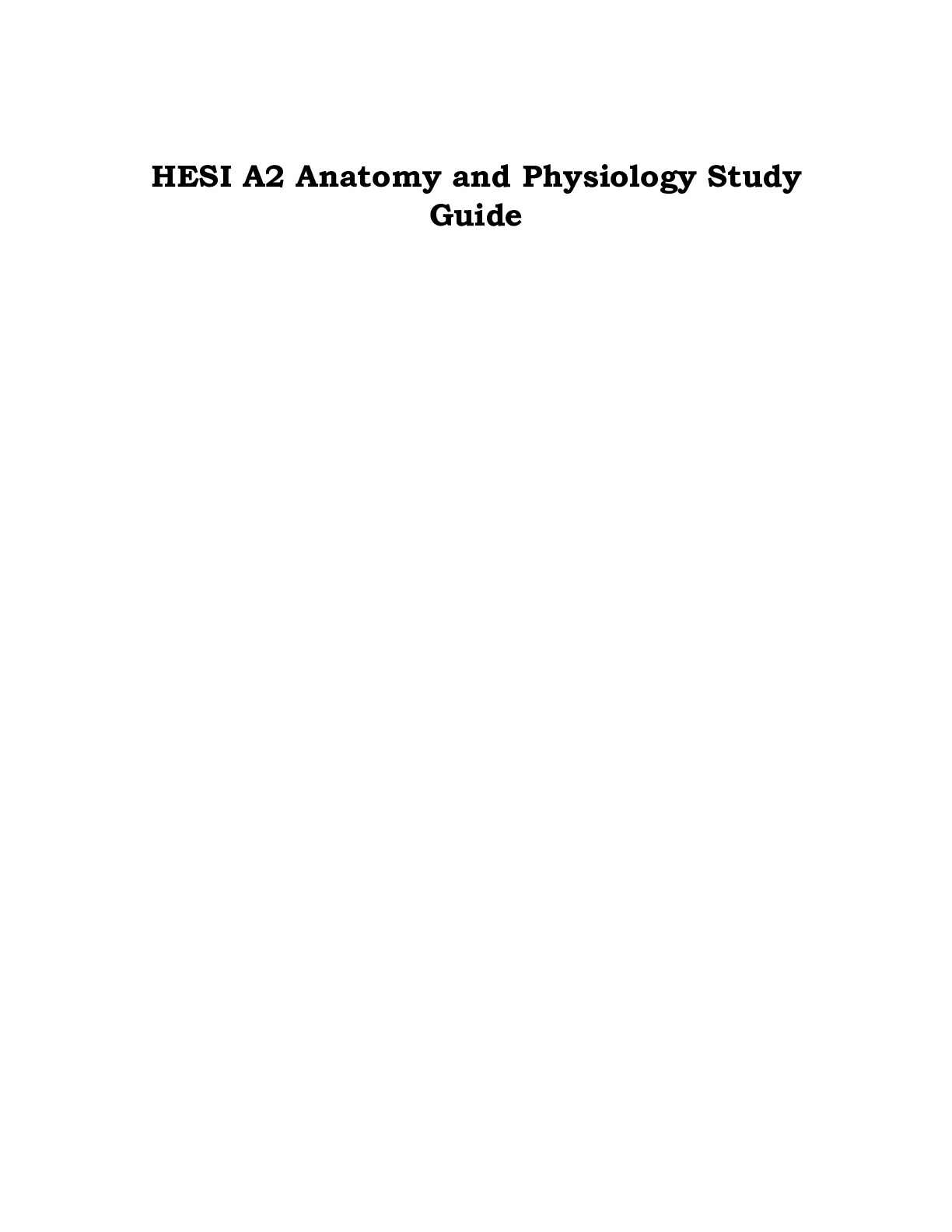
Reviews( 0 )
Document information
Connected school, study & course
About the document
Uploaded On
Jan 27, 2021
Number of pages
111
Written in
Additional information
This document has been written for:
Uploaded
Jan 27, 2021
Downloads
0
Views
71
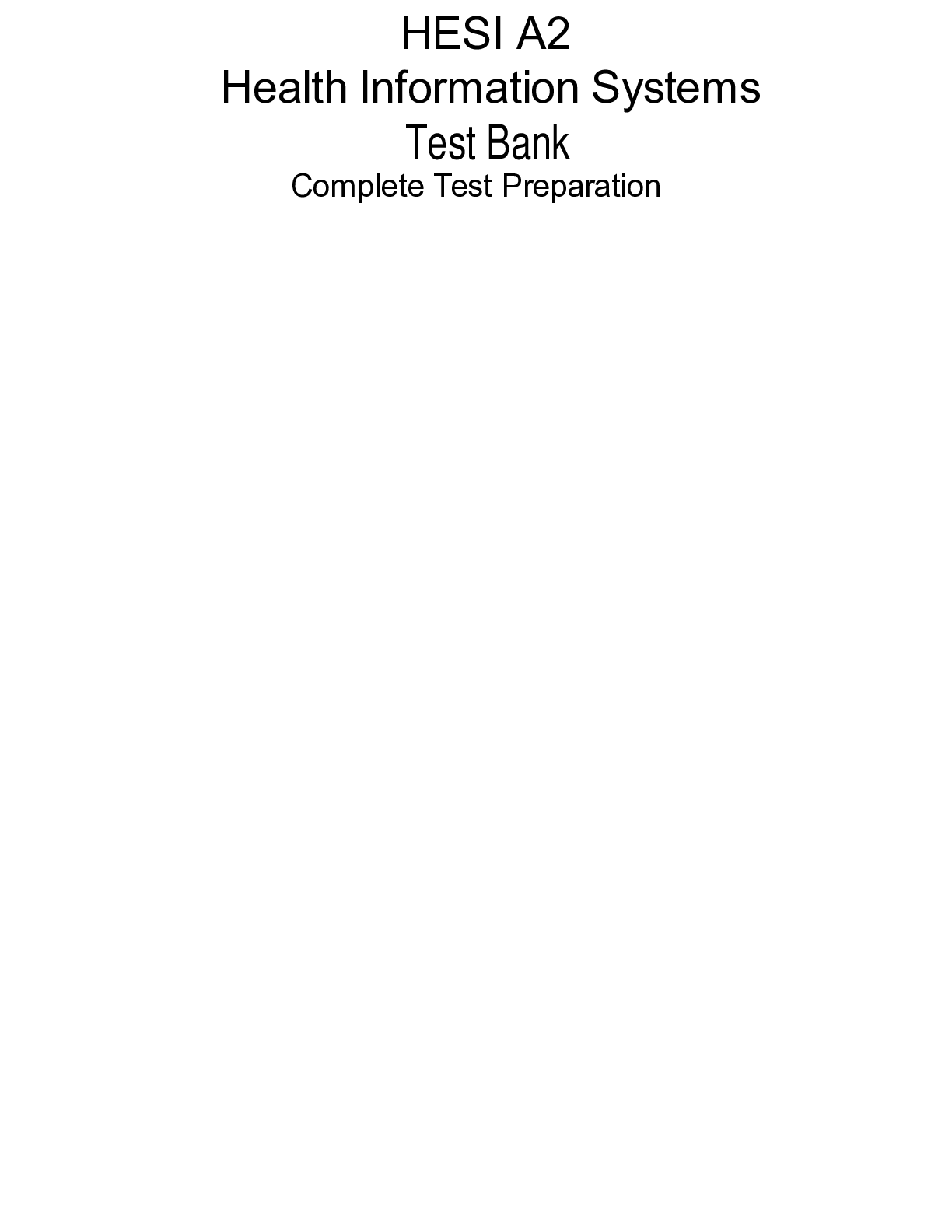


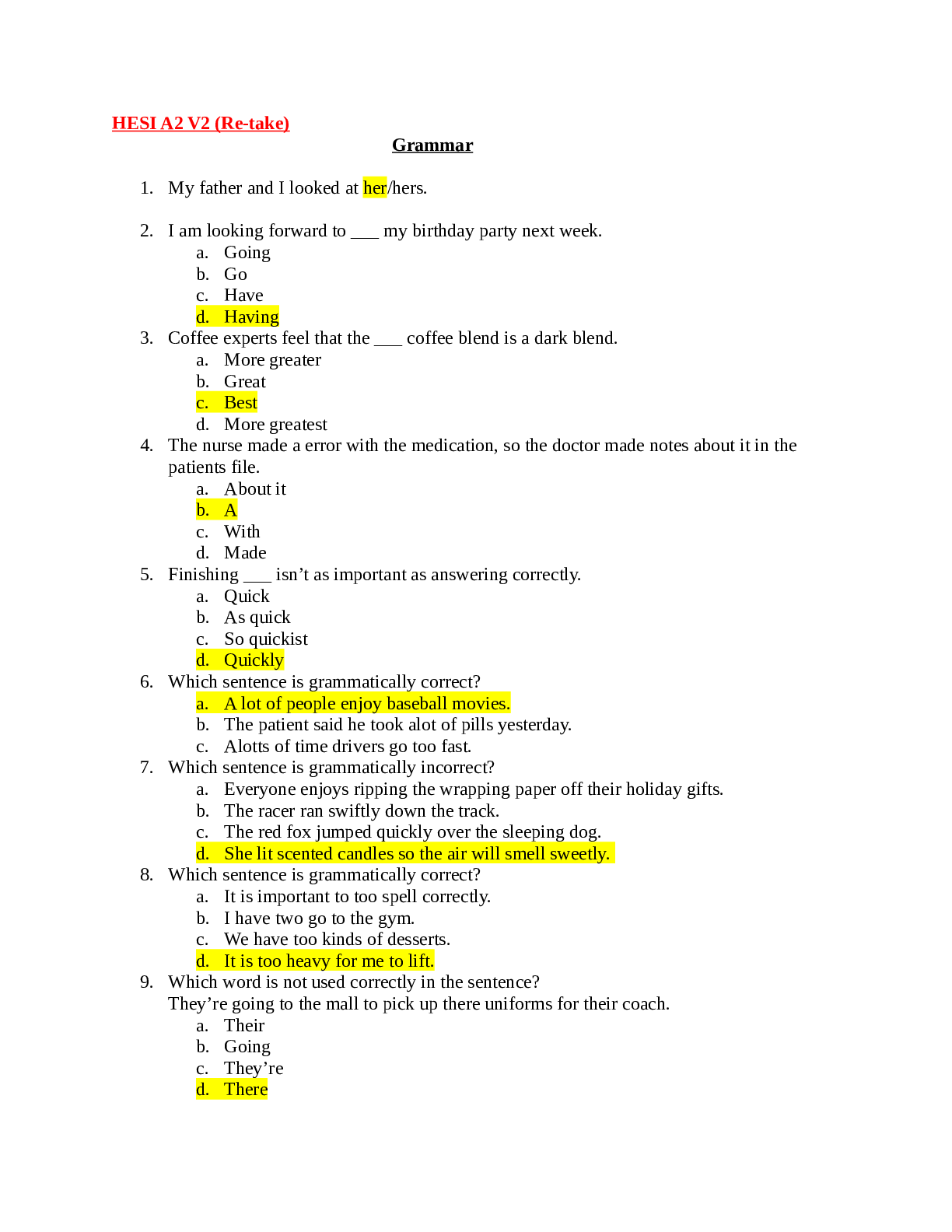

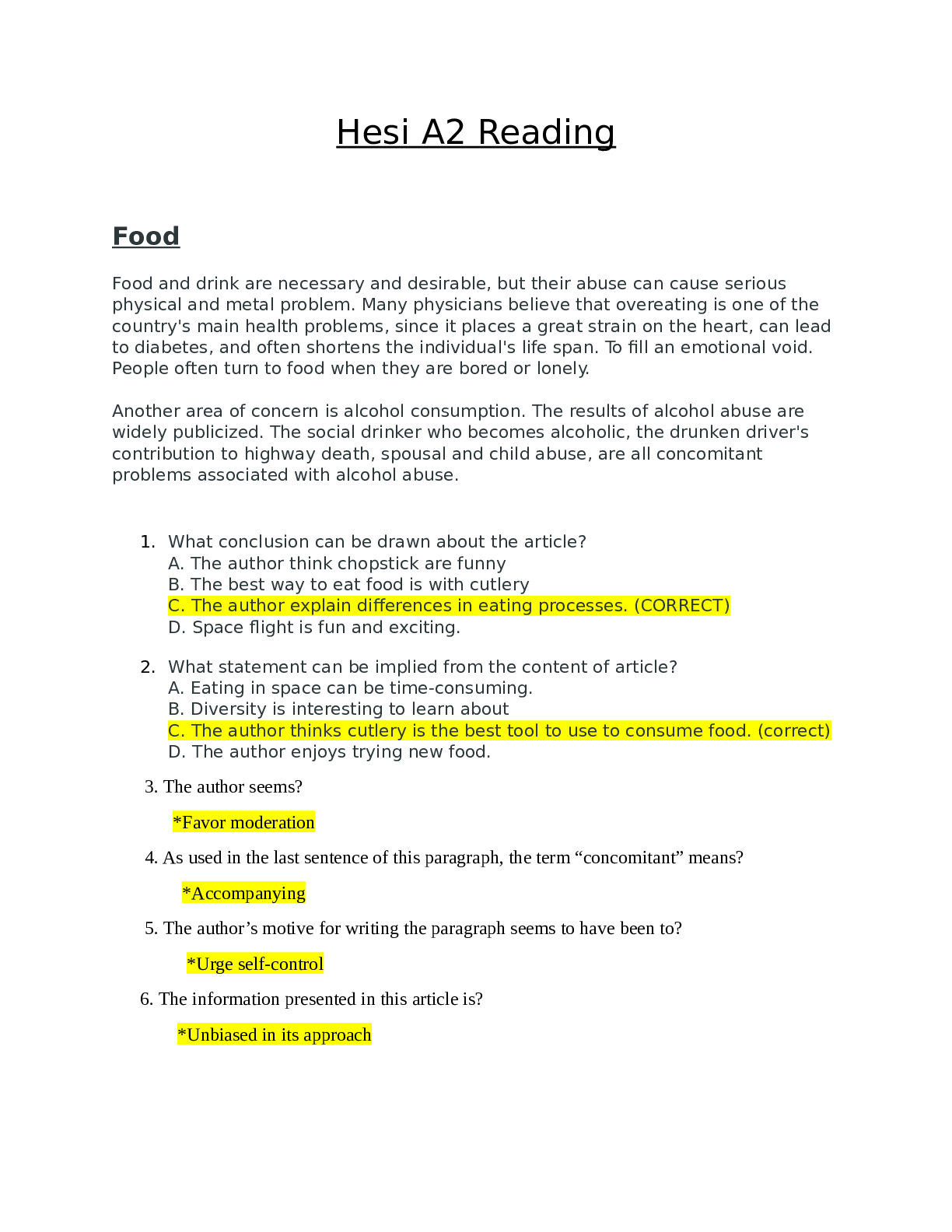
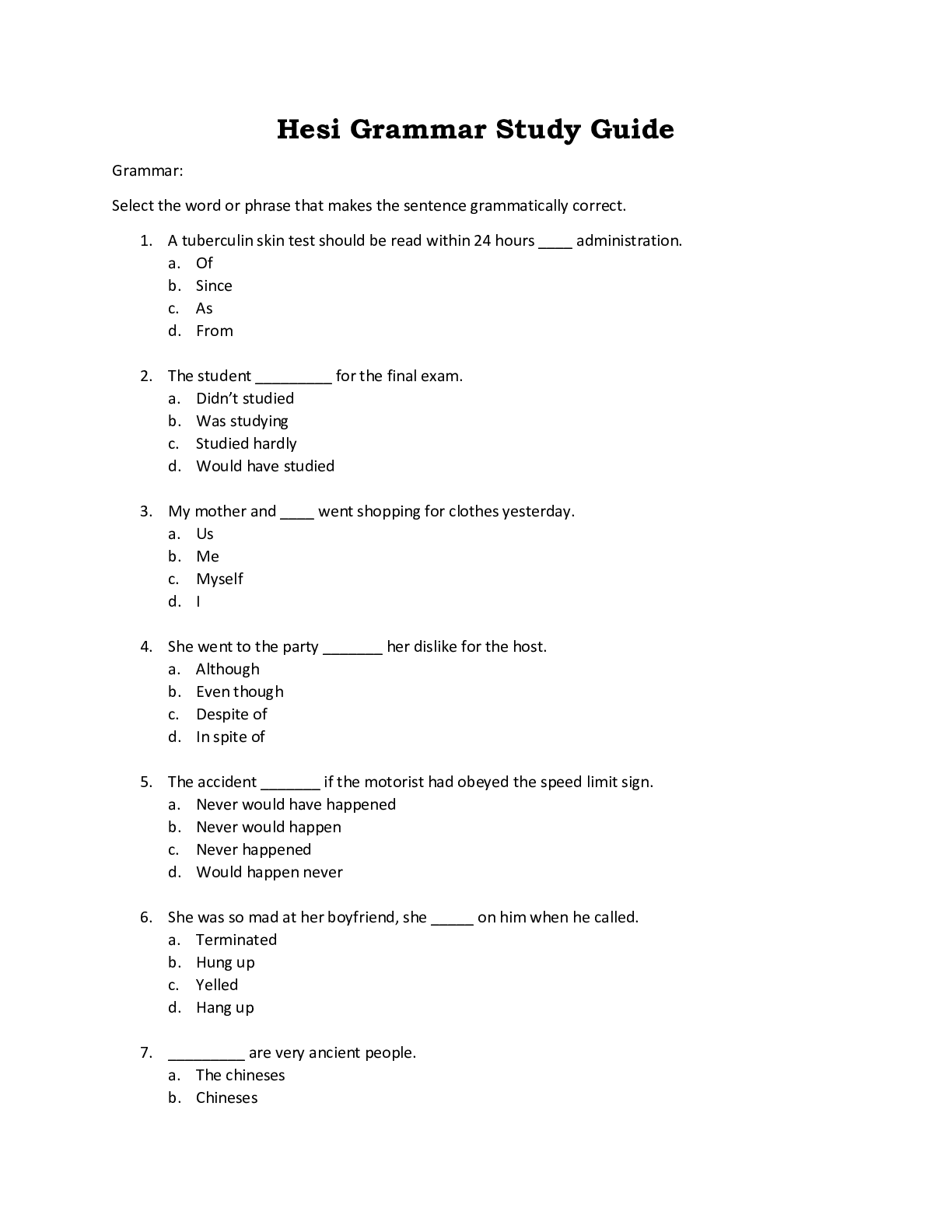

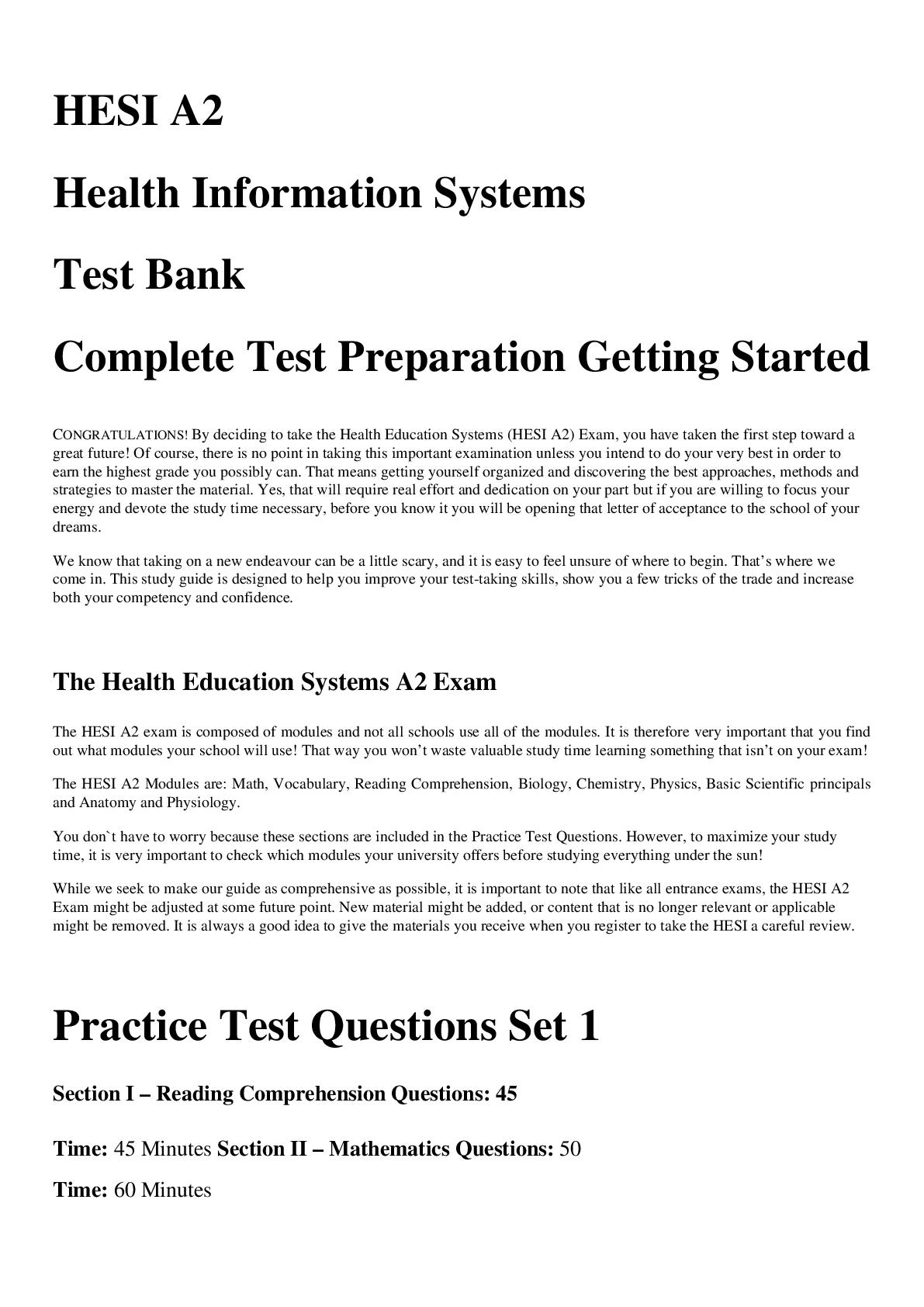
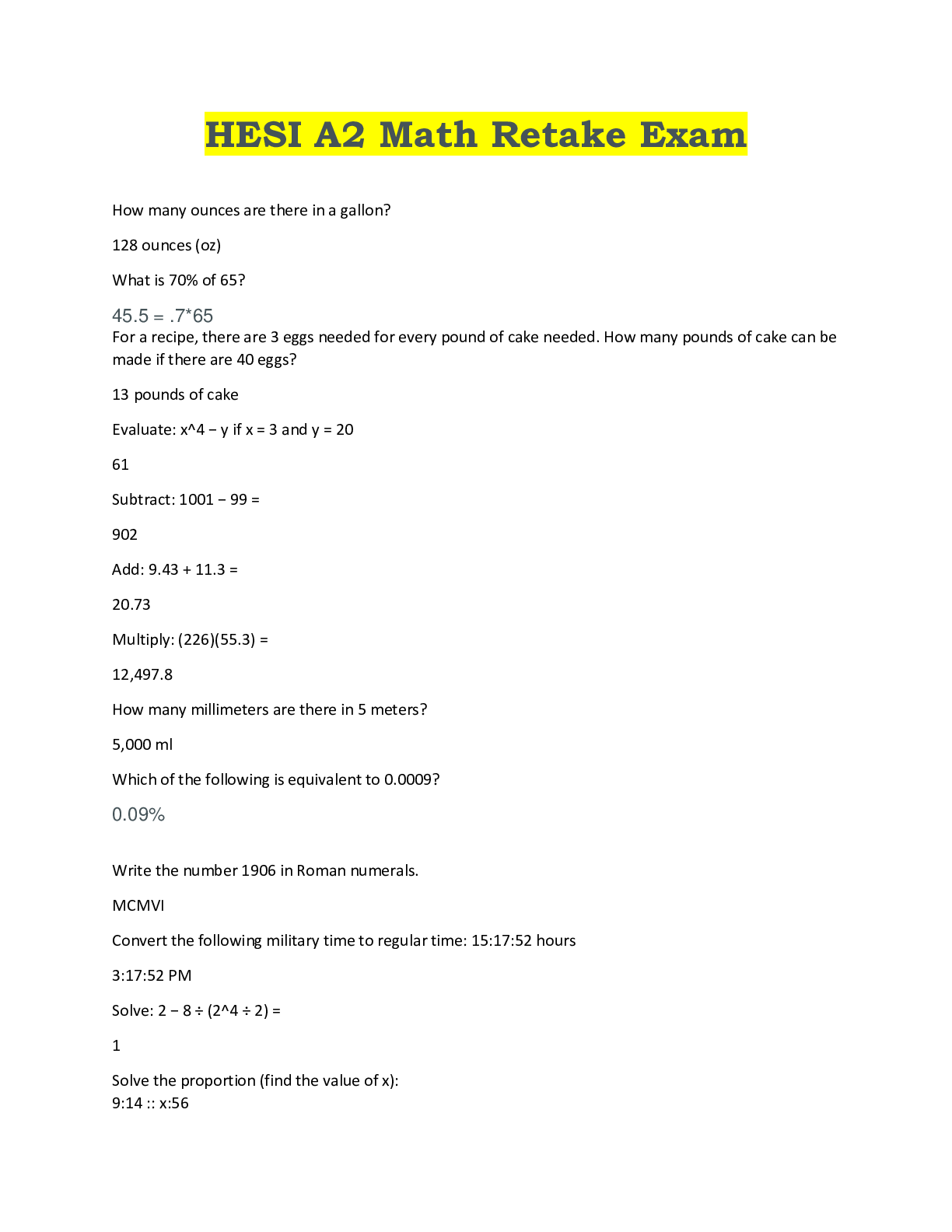
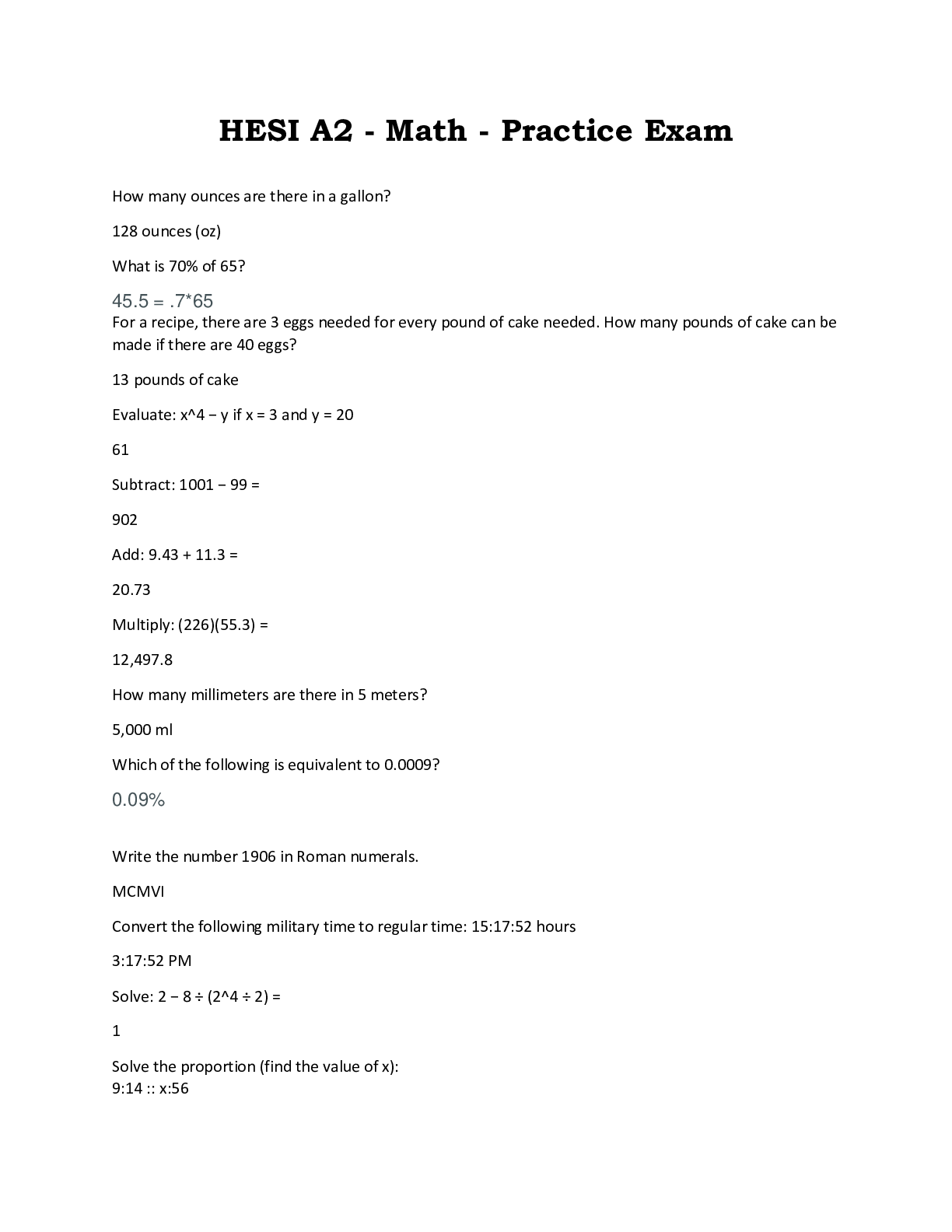
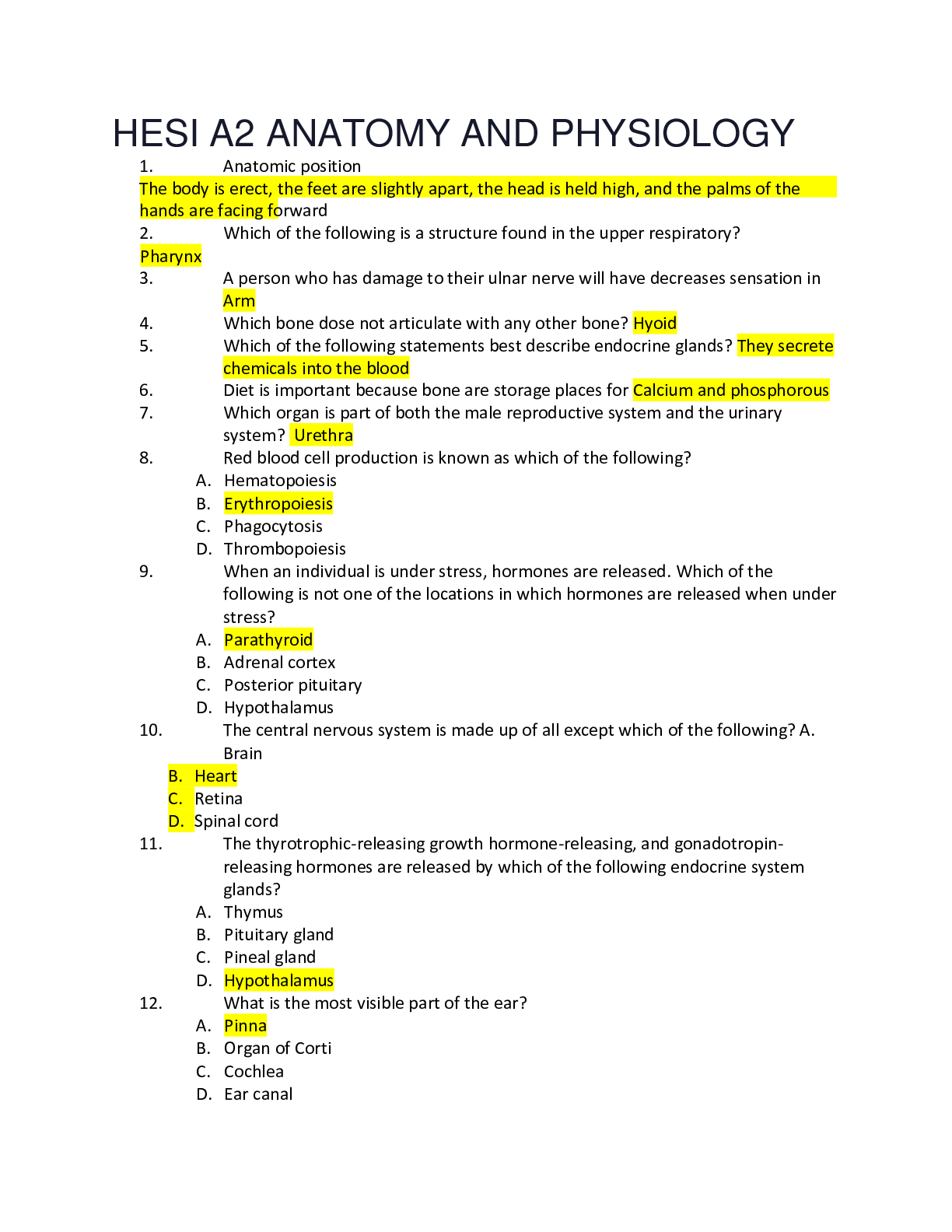
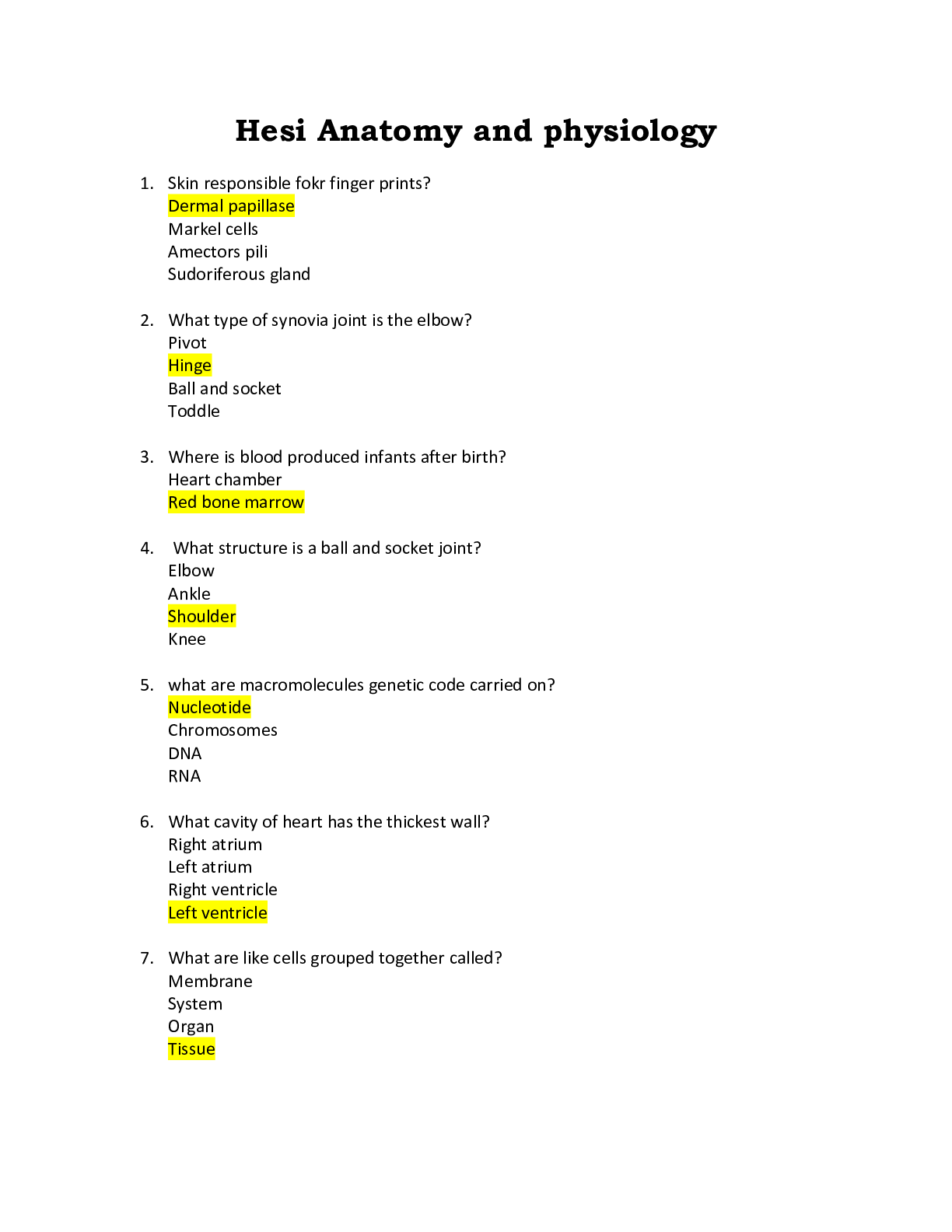
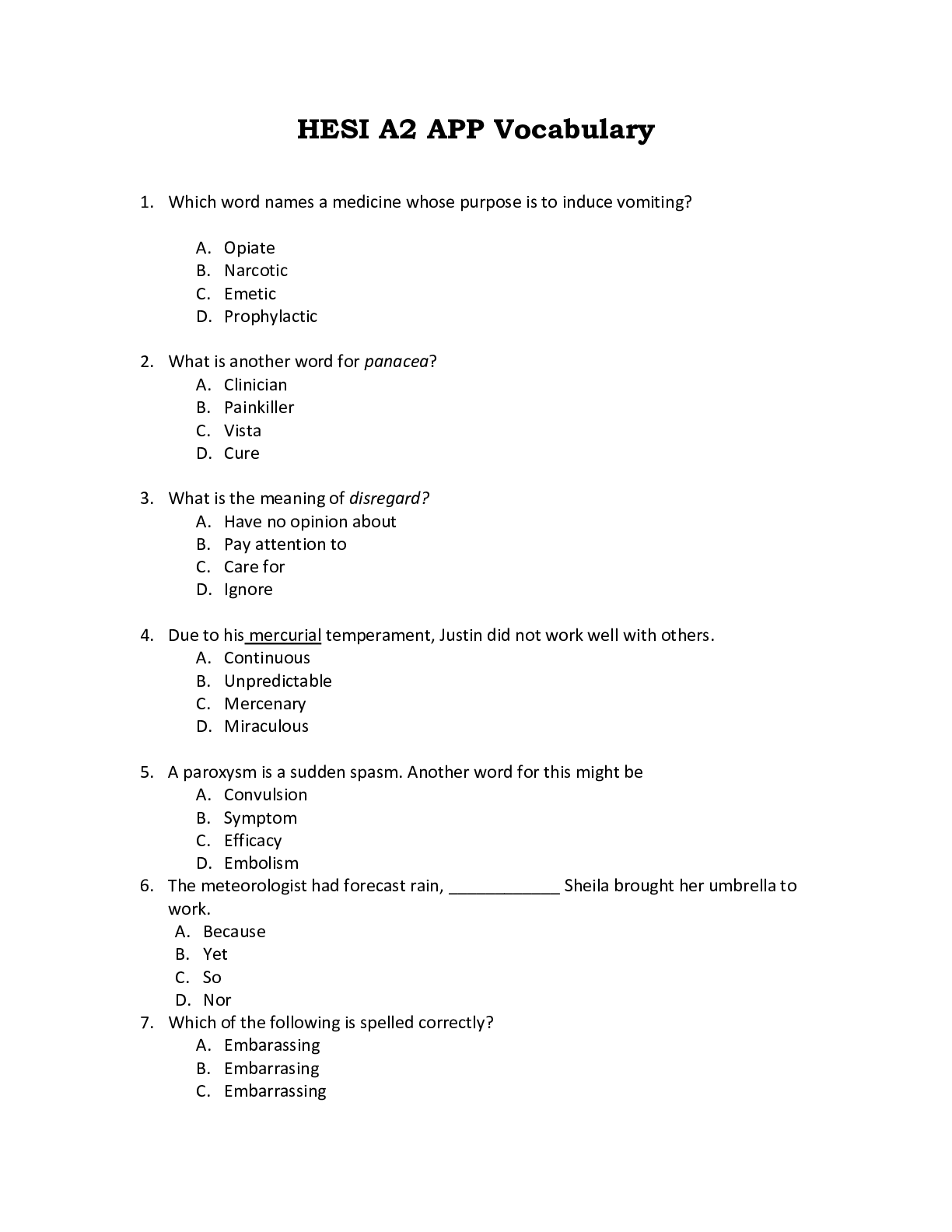
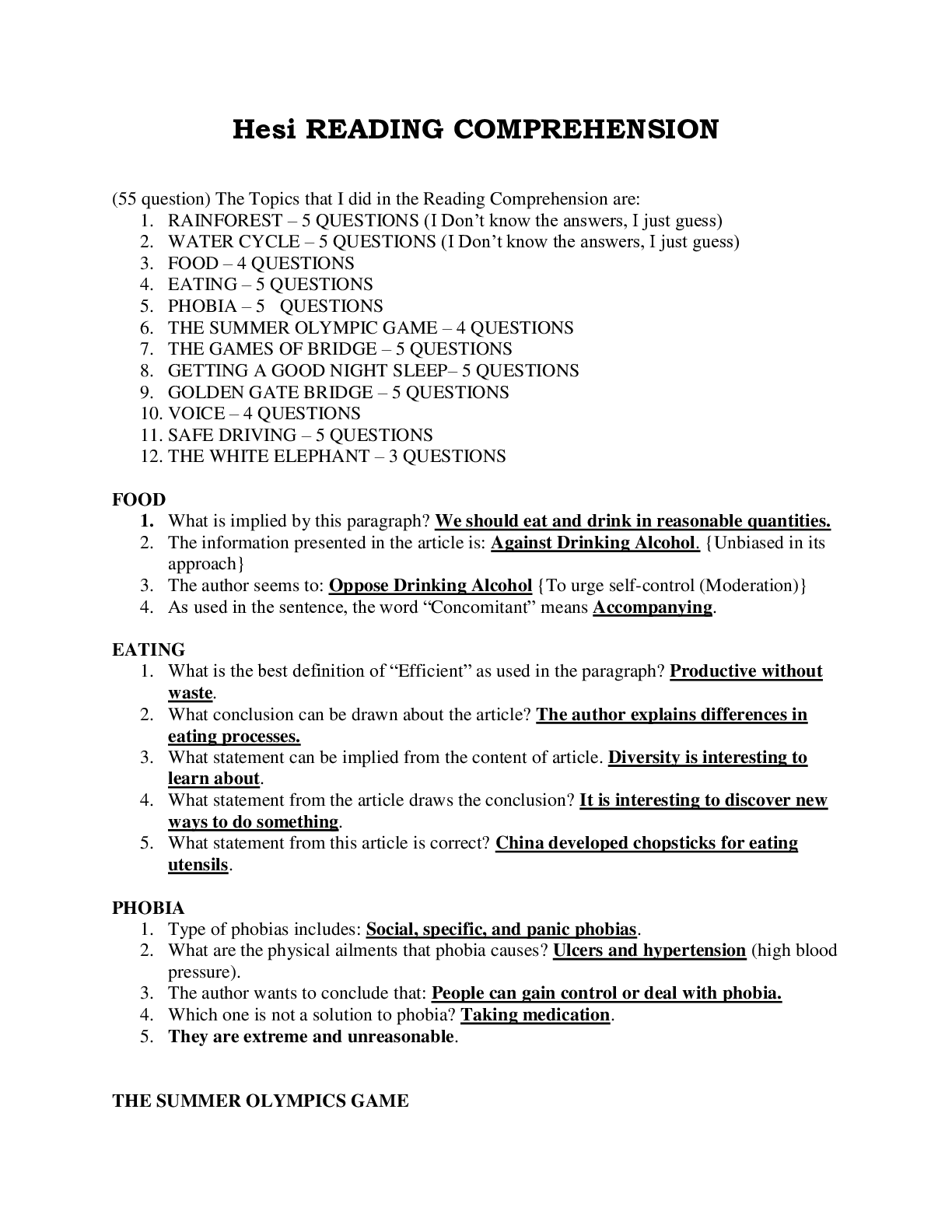
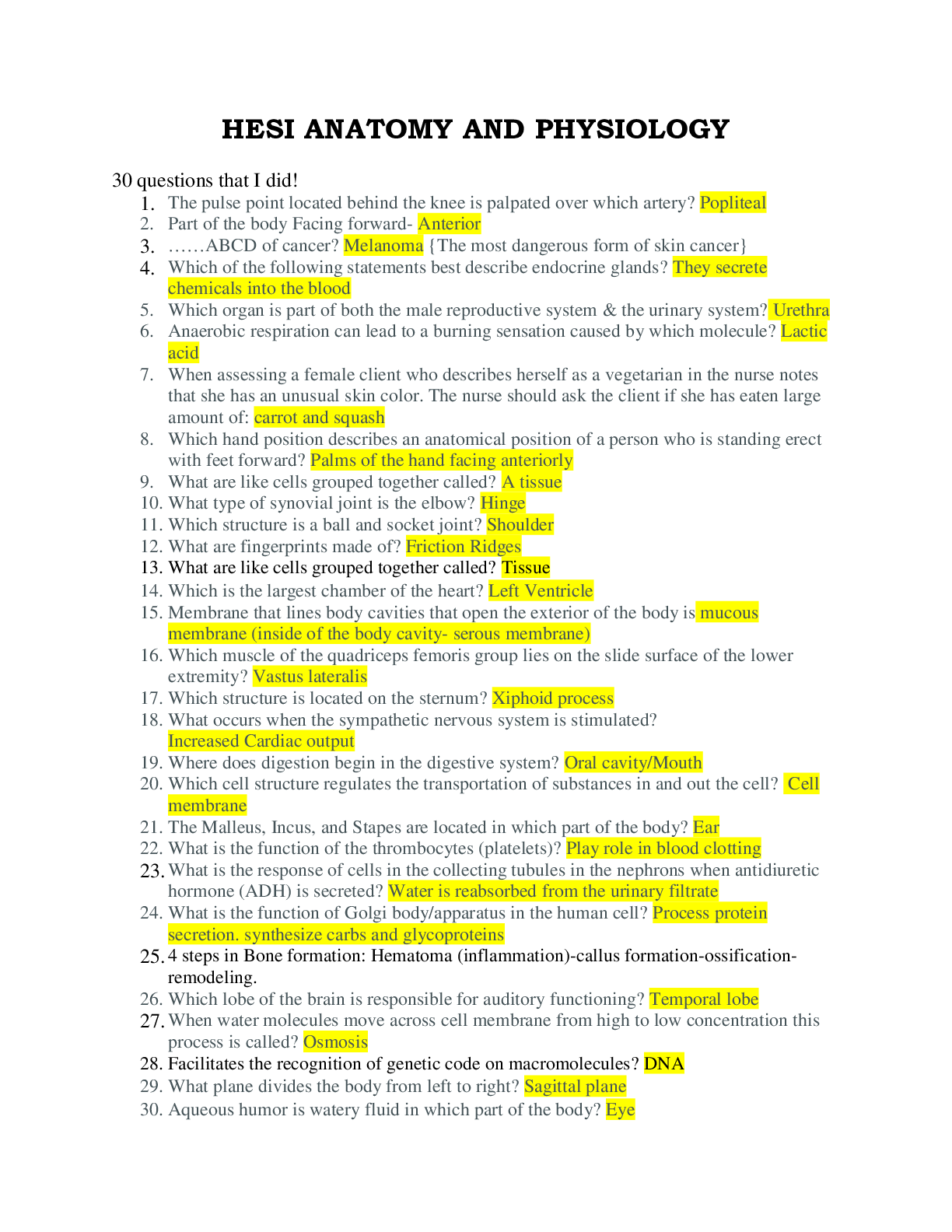
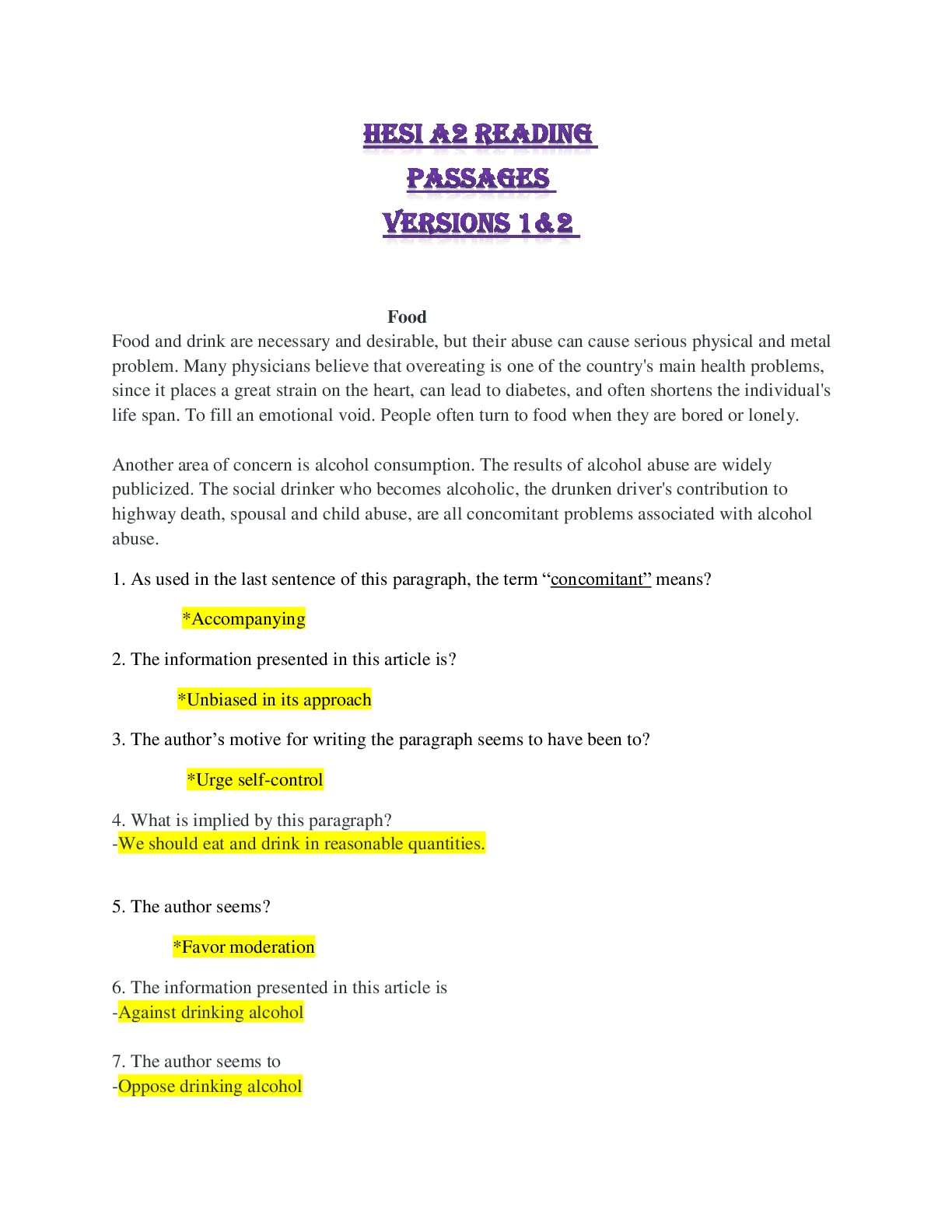
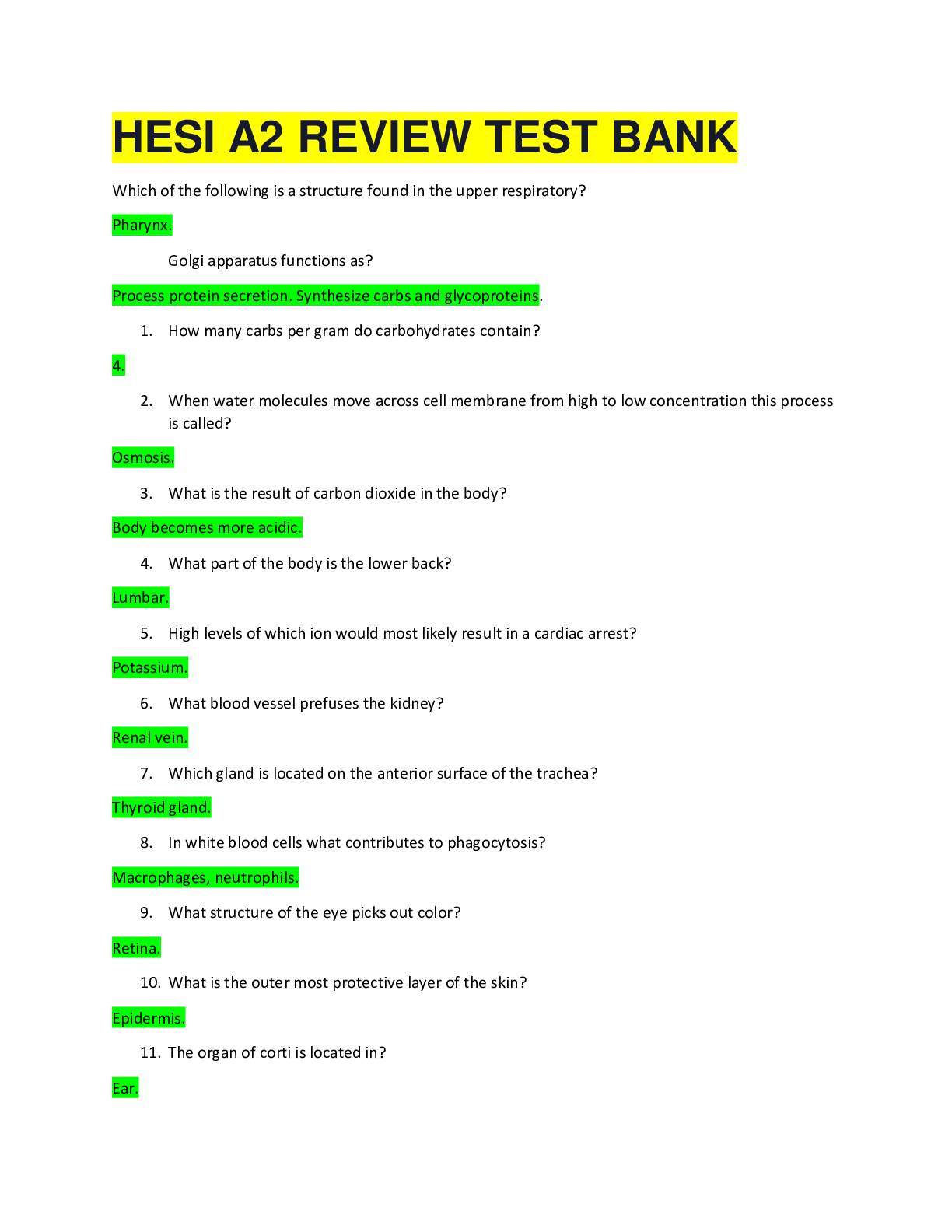
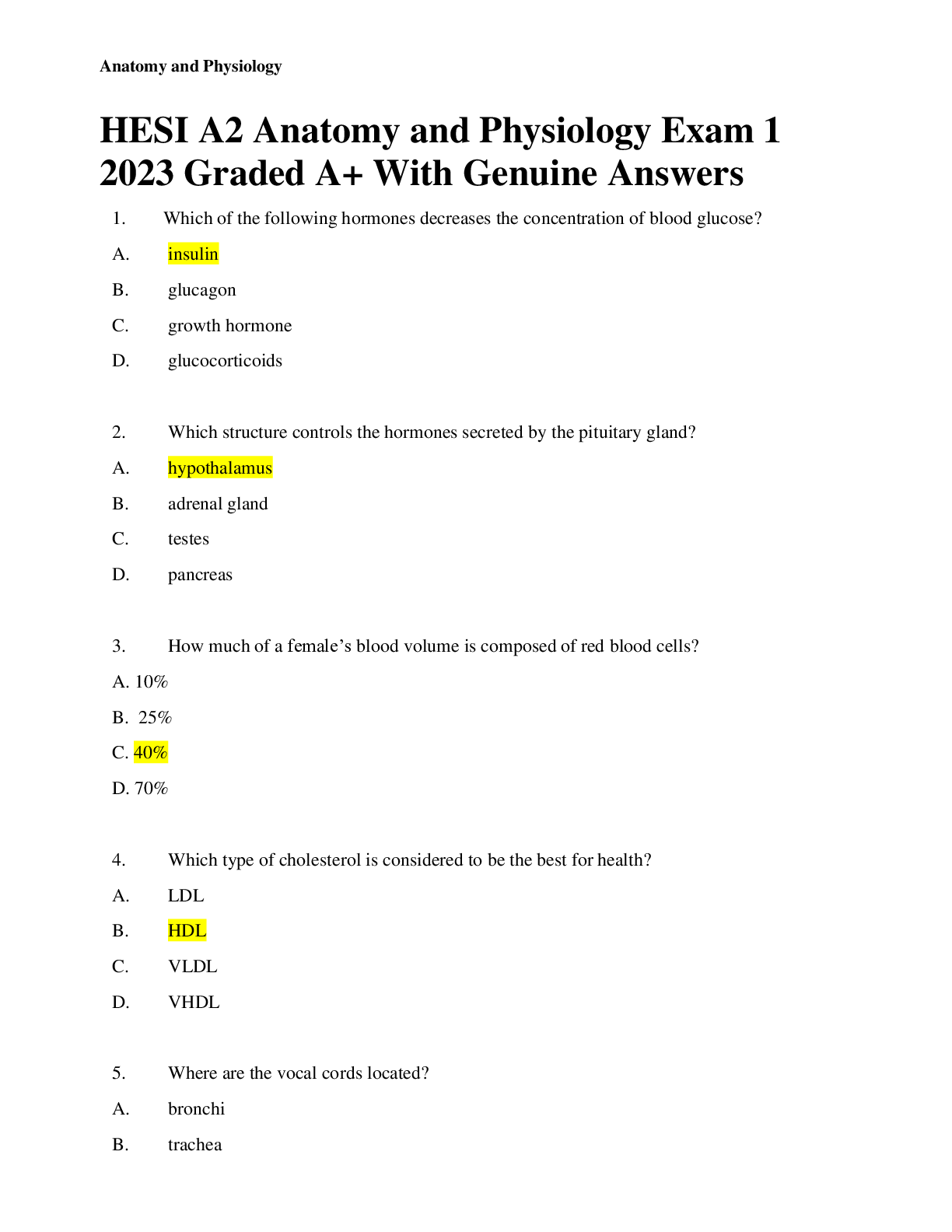
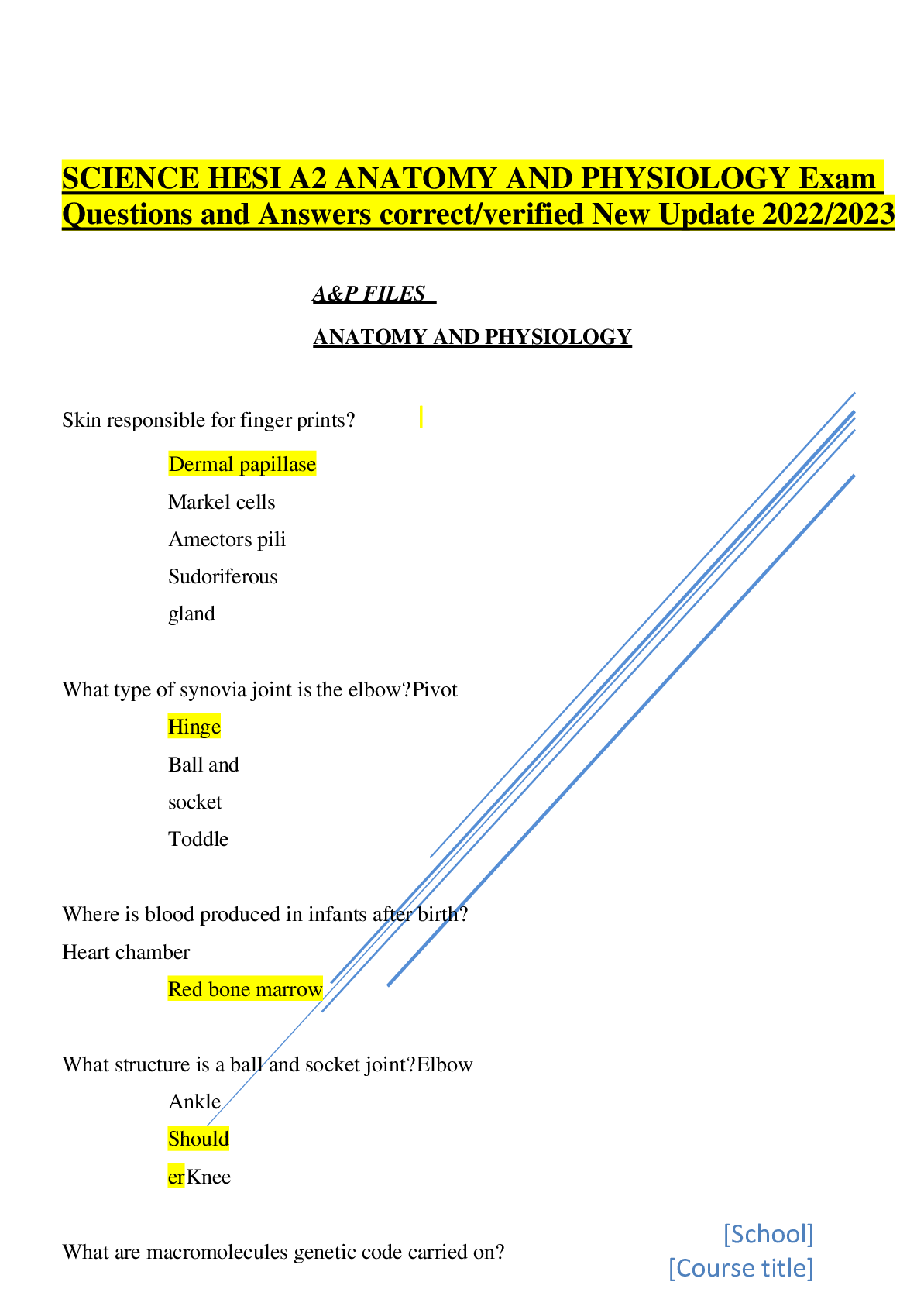
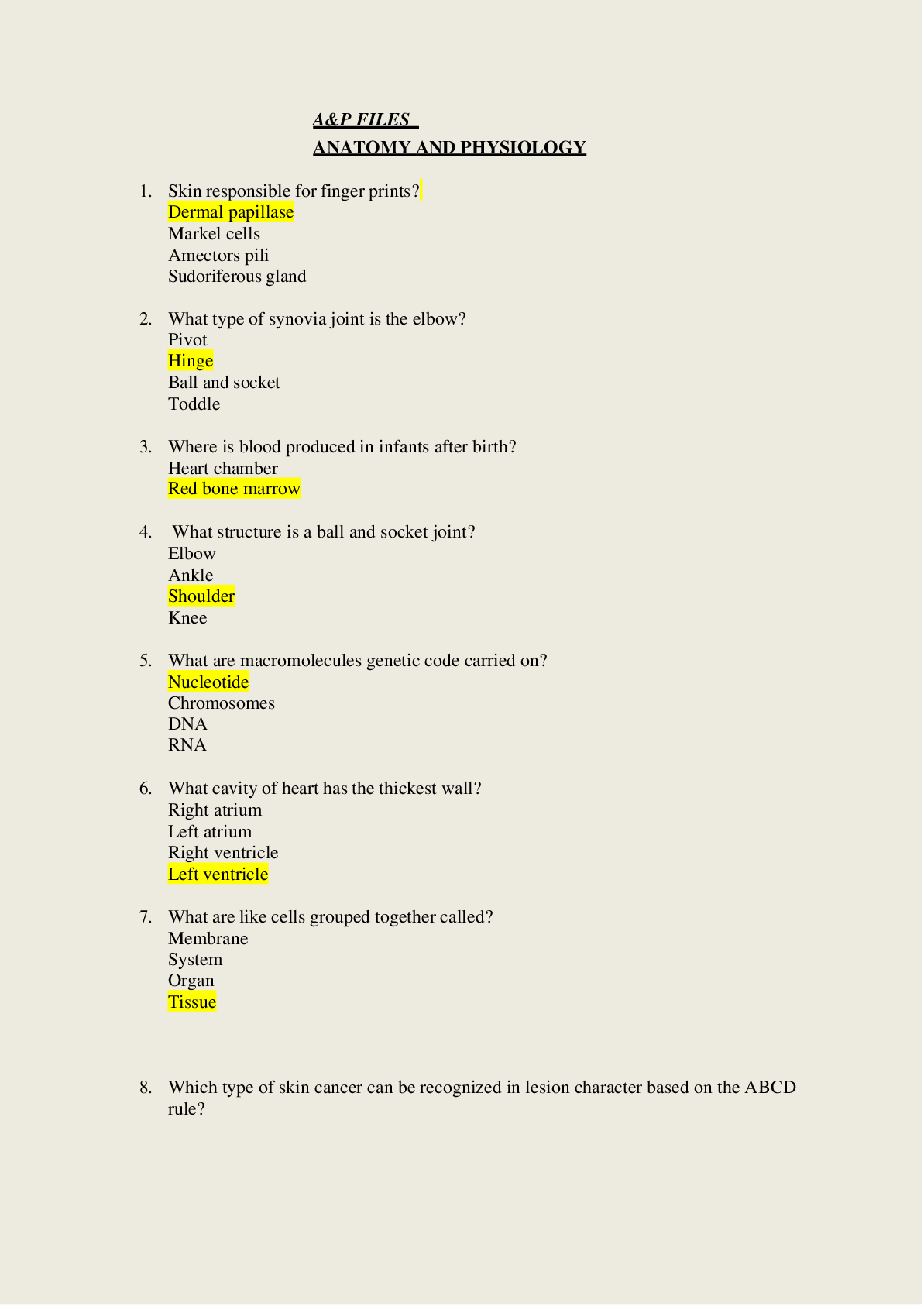
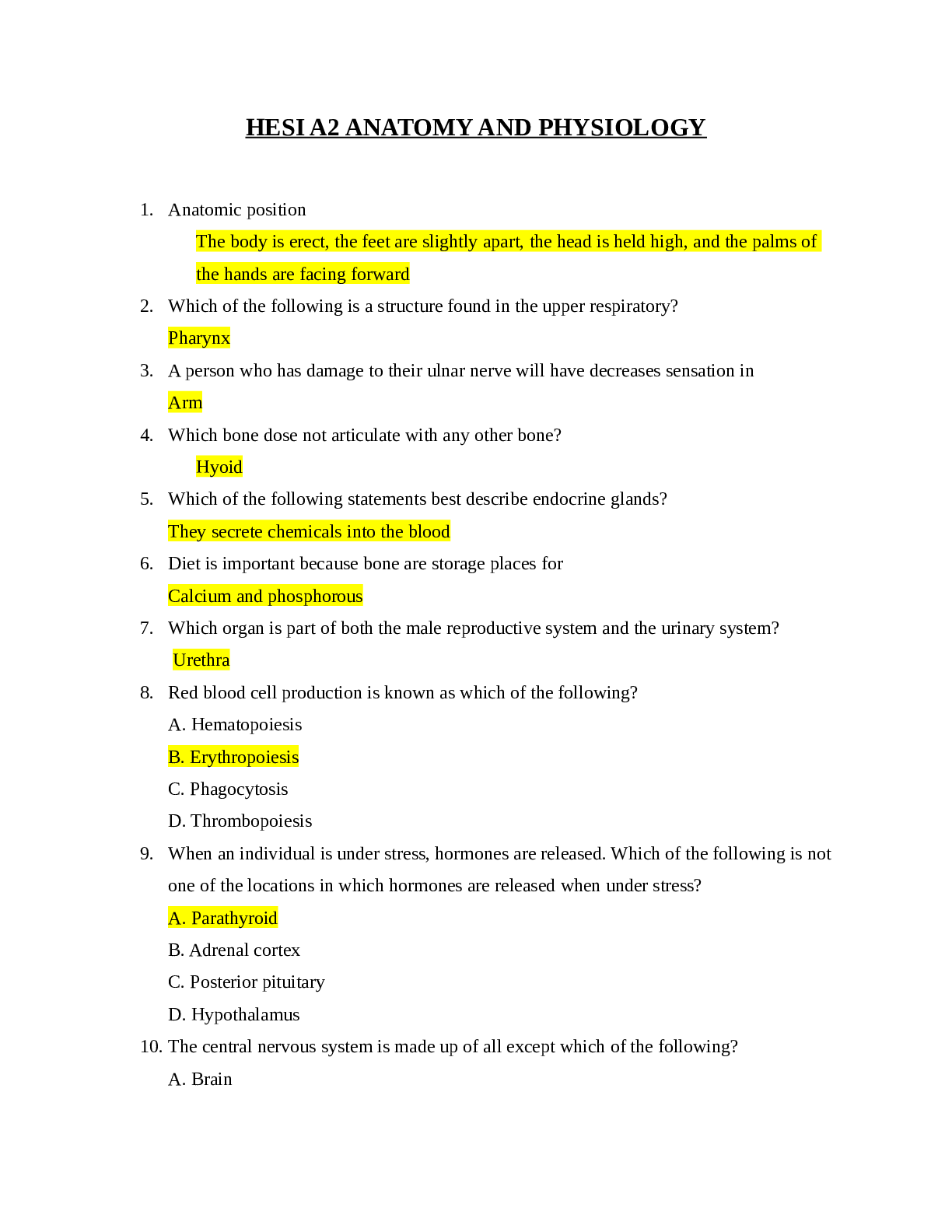
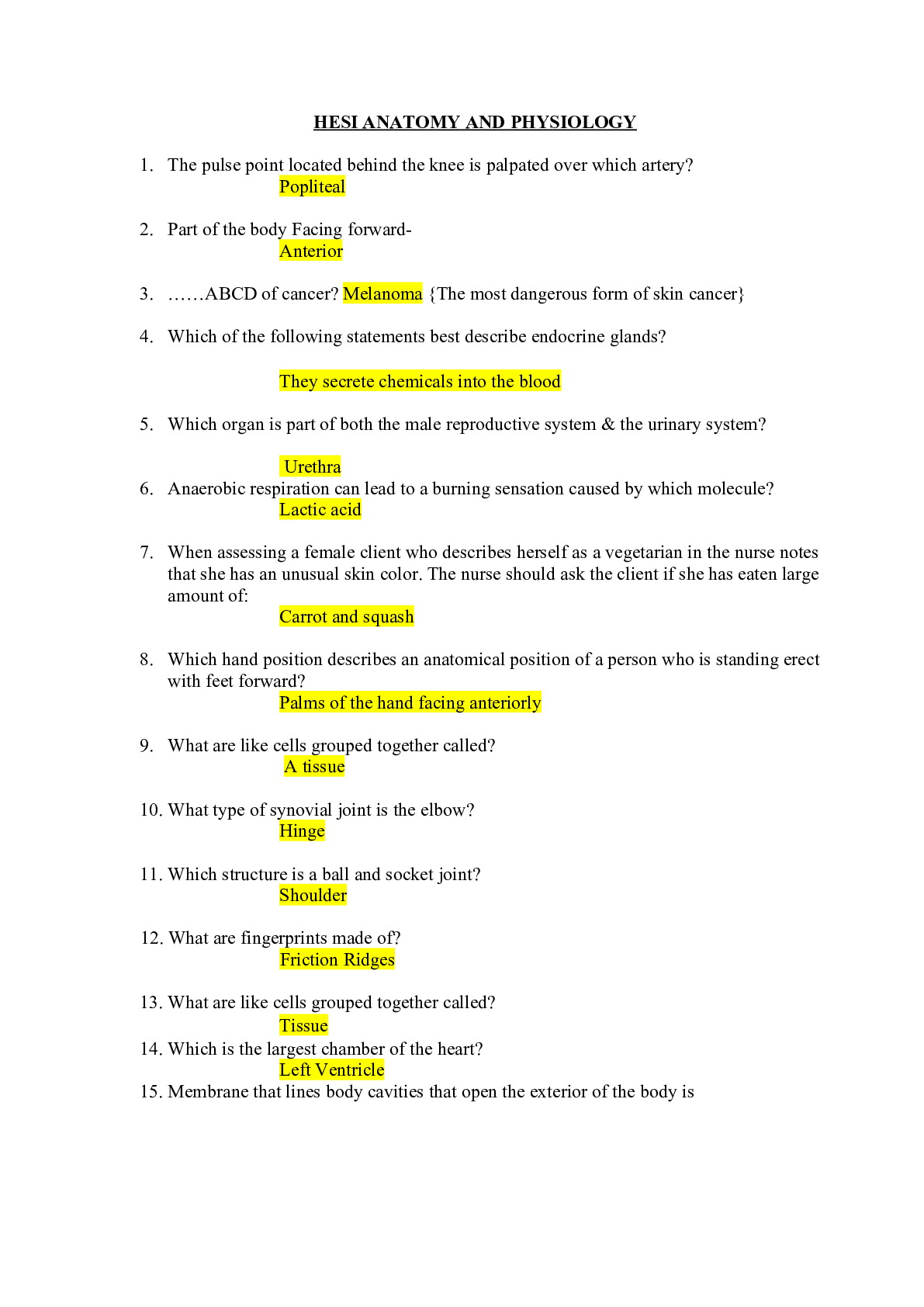
 LATEST QUESTIONS AND COMPLETE SOLUTIONS.png)

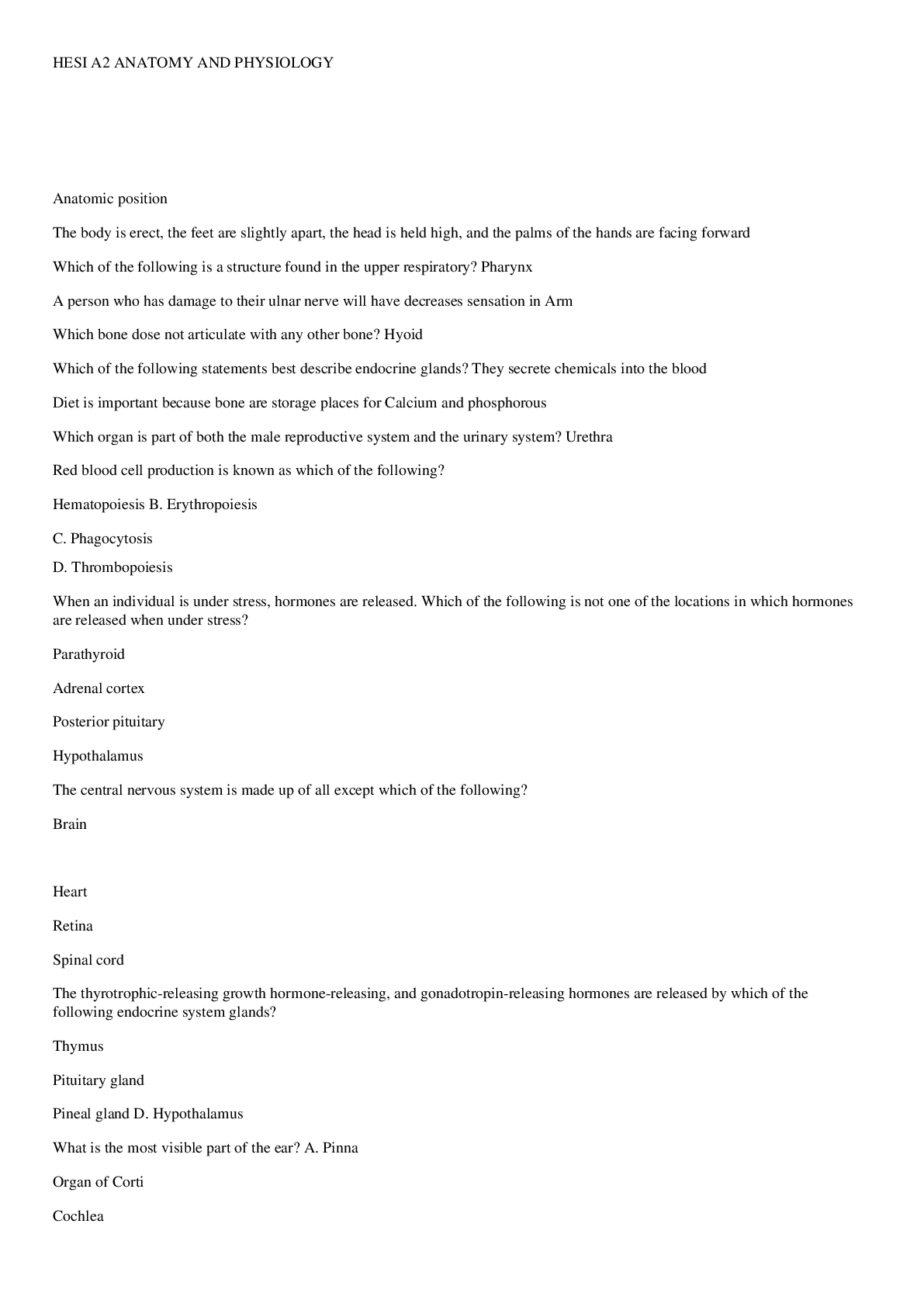
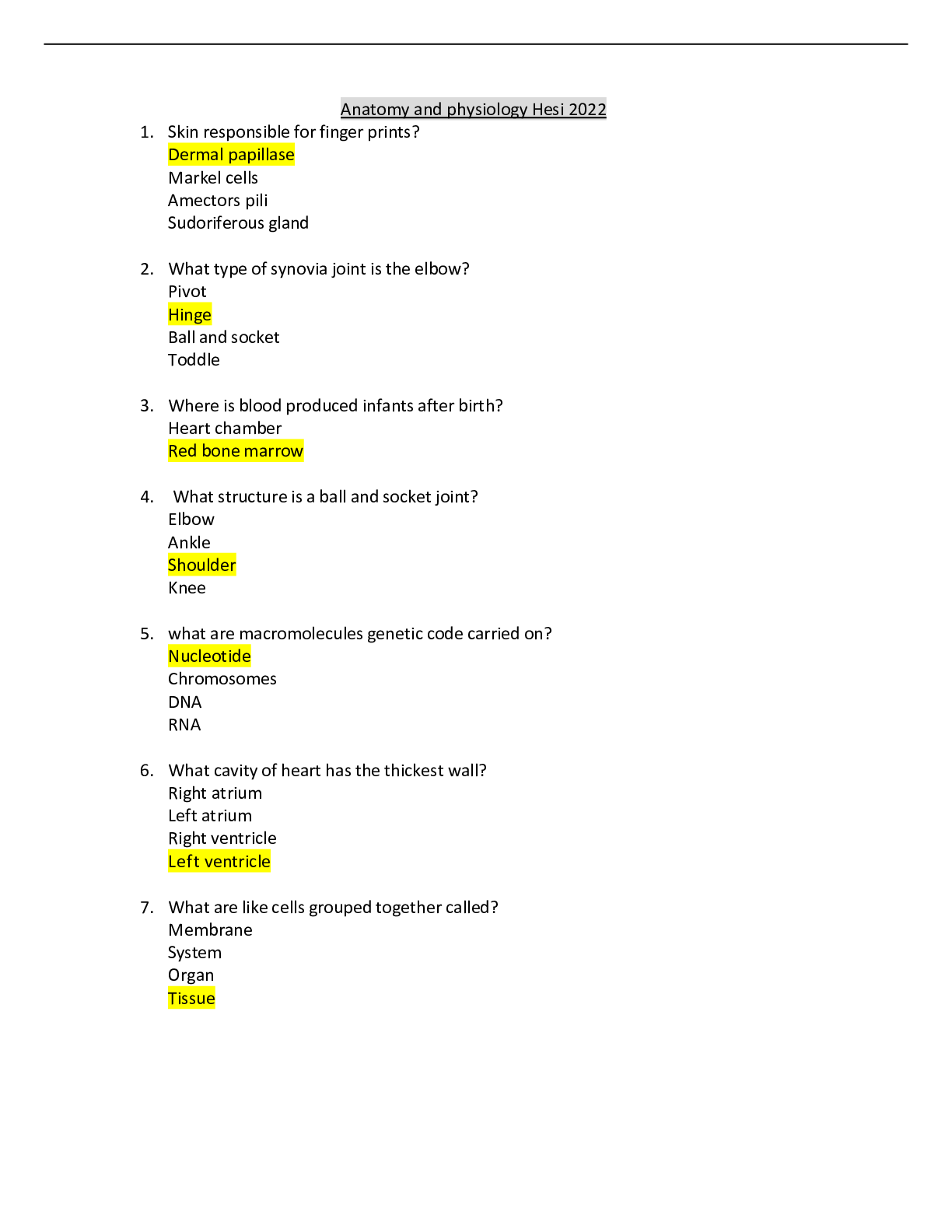

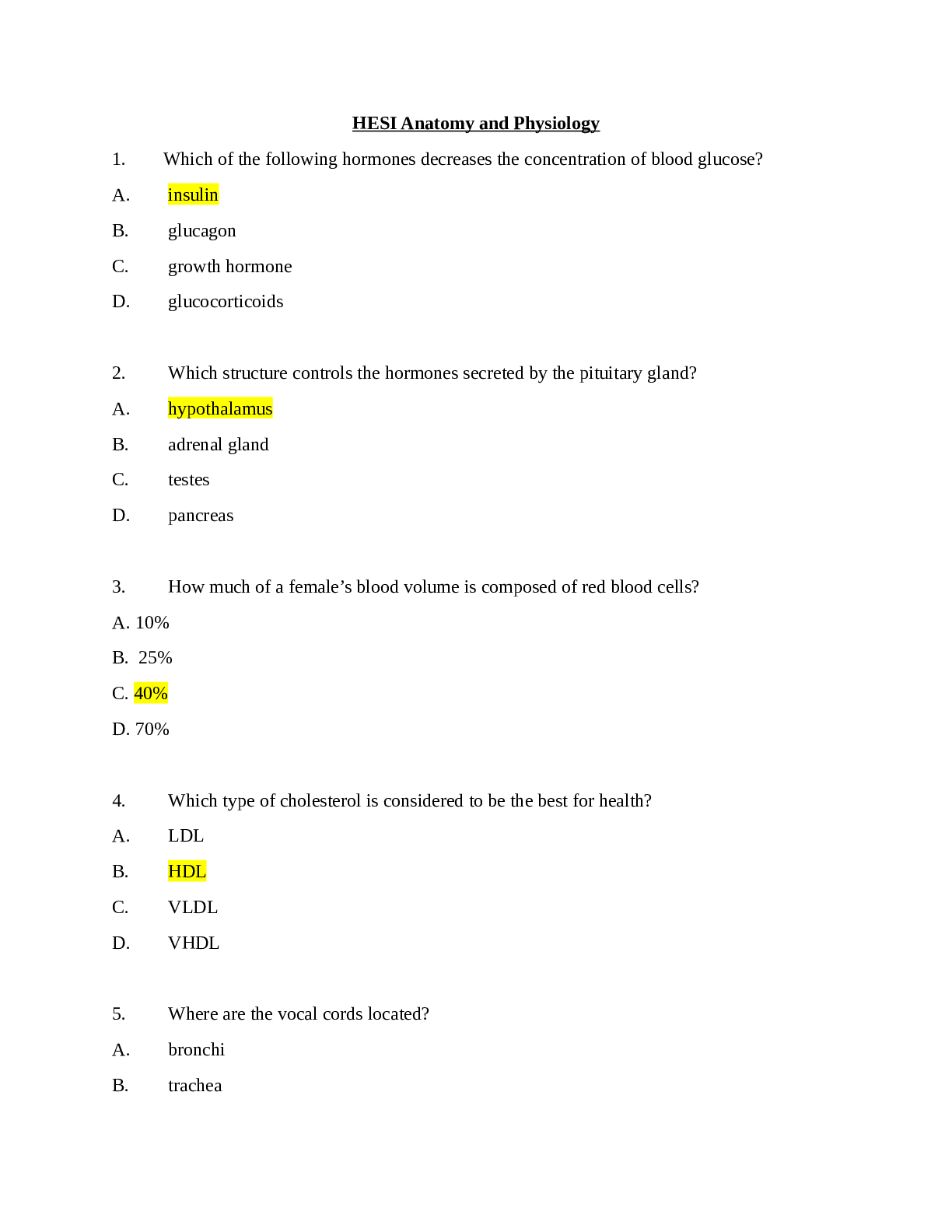

 LATEST GUIDE 2022.png)
.png)
